Matador Network's Blog, page 8
September 23, 2025
13 Coastal Airbnbs Perfect for Escaping Winter Cold

It’s only September, but you know what’s coming. Some people embrace winter — they wax their skis, swaddle in wool, and insist they actually enjoy short, gray days. And then there are the rest of us, who know ourselves well enough to admit that by January we’ll be miserable. The light therapy lamp won’t be cutting it, our boots will always be wet, and every time we step outside, we’ll swear it’s the coldest we’ve ever felt.
If you fall into that camp, don’t let a warm-weather getaway be an afterthought. By the time December rolls around, all the best Airbnbs in sunny places will already be booked. Instead, plan ahead and give yourself something to look forward to — a midwinter escape where “layering up” means a billowing kaftan and the only hazardous ice is the oversized hipster cube in your cocktail. And luckily you don’t have to go far. From Mexico to California to Puerto Rico, these coastal Airbnbs are worth bookmarking now, so when the dark days hit, your escape plan is already in place.
We hope you love the spaces and stays we recommend! Just so you know, Matador may collect a small commission from the links on this page if you decide to book a stay. Listed prices are accurate as of the time of publication.
Bohemian beachfront home with deck and whale watching in Ventura, California Photo: Airbnb
Photo: Airbnb Photo: Airbnb
Photo: Airbnb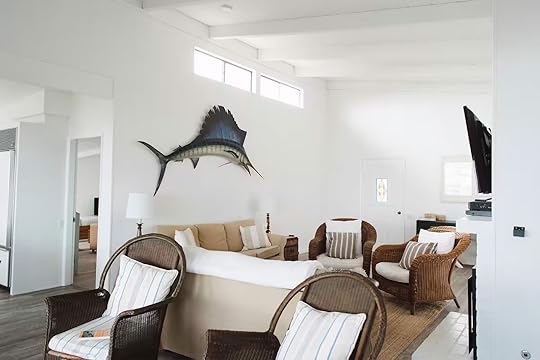 Photo: Airbnb
Photo: Airbnb Photo: Airbnb
Photo: AirbnbSee more photosBlending traditional and modern design, this house features oceanfront views and contemporary amenities from a superb location at Faria Beach. Get cozy inside this dreamy space and gaze out the large windows at the water, or watch the surf and look for wildlife like whales while getting some fresh air on the spacious private deck. The “beachy” feeling space emits a sense of relaxation and eclecticism, with nautical decor elements like seashells and light blue and whitewashed walls.
The living, dining and kitchen areas are oceanfront — meaning idyllic views. Make a meal in the fully equipped kitchen with a dishwasher and subzero refrigerator. There are two main bedrooms with clean and comfortable queen beds on the main level, and the sleeping space is in the family-style living room, with two twin beds and a couch, TV, and laundry machine.
Six guests, three bedrooms
Price: $930 per night
 Photo: Airbnb
Photo: Airbnb Photo: Airbnb
Photo: Airbnb Photo: Airbnb
Photo: Airbnb Photo: AirbnbSee more photos
Photo: AirbnbSee more photosPadre Island, also known as North Padre, is surprise, surprise, north of the laid-back South Padre Island near Brownsville, Texas. To complicate this further, I’m adding Mustang Island to the mix and suggest staying in Port Aransas. Mustang Island is accessible by a ferry from the north or a bridge from the top of Padre. The entire region deserves exploration, so base yourself in Port Aransas, bring or hire a vehicle, and allow yourself time to enjoy the miles of sandy beaches and the climate of the tropical southern tip of Texas.
One to bookmark, this is the ultimate beach house. You’ll be set up for success with a stay here as the hosts have thought of everything. Entertainment is sorted with the game room with arcade machines, outdoor games for the yard, and a private heated pool with an outdoor shower. There’s a built-in EV charger, complimentary beach gear, and the rental comes with a six-seater golf cart for zooming around the island.
12 guests, four bedrooms
Price: $750 per night
 Photo: Airbnb
Photo: Airbnb Photo: Airbnb
Photo: Airbnb Photo: Airbnb
Photo: Airbnb Photo: AirbnbSee more photos
Photo: AirbnbSee more photosAn hour north of Cabo but a world away in atmosphere, Todos Santos skips the resort sprawl in favor of cobblestone streets, colorful art galleries, and a distinctly bohemian pace. Winter brings clean Pacific swells that keep surfers paddling out at Playa Cerritos, while in town you can wander between craft coffee shops, taco stands, and small studios before catching one of Baja’s signature fiery sunsets.
Staying in Todos Santos usually means choosing between tucked-away casitas near the town’s galleries or modern villas with views of the Pacific. This three-bedroom home sits right at that intersection — close to shops and restaurants but perched above an arroyo with sweeping mountain and ocean views. The design blends contemporary lines with hacienda-style details, and each bedroom opens to the outdoors. A chef’s kitchen, shaded dining patio, and a lap pool for cooling off make it an easy base for exploring town or the beaches just down the road.
Six guests, three bedrooms
Price: $615 per night
The most sought-after ski-in/Ski-out Airbnbs in Big Sky Montana for groups and families The 63 Most Exciting New Hotels of 2024 Cliff House with stunning pool and waterfall view in Maui, Hawai’i
 Photo: Airbnb
Photo: Airbnb Photo: Airbnb
Photo: Airbnb Photo: Airbnb
Photo: Airbnb Photo: Airbnb
Photo: AirbnbSee more photos
Winter in Maui means peak humpback whale season. Every year, thousands of whales migrate from Alaska to the warm Hawaiian waters to give birth and raise calves, and sightings are almost guaranteed from December through April. The beaches around Kāʻanapali and Wailea are perfect for spotting spouts offshore, and guided whale-watching tours get you even closer to the action. Add in warm ocean temps for snorkeling, lush hikes through ‘Iao Valley, and the Road to Hana’s waterfalls — Maui delivers both adventure and relaxation in the middle of winter.
This epic cliff house, 300 feet above the ocean, encapsulates everything great about a stay on Maui. The ocean is right there, you have a private pool and hot tub, and you can relax over cocktails while gazing at the Hanehoi Waterfall. Hana is visible from the home, as is the north coast of Maui. Relax over a book next to the 10-foot marble fireplace, though focusing on the pages may prove to be a struggle with the scenery of paradise in the background. You’ll never have a better view from a hot tub, this we can guarantee. For more stunning Airbnbs on the island, check out Matador’s wider selection of Maui Airbnbs and other great finds on Hawai’i’s beaches.
Three guests, one bedroom
Price: $481 per night
 Photo: Airbnb
Photo: Airbnb Photo: Airbnb
Photo: Airbnb Photo: Airbnb
Photo: AirbnbOn Puerto Rico’s west coast, Rincón earns its reputation as the “surfing capital of the Caribbean.” From December to March, the waves are at their best, drawing surfers from around the globe. But it’s not just for board riders: the town is famous for golden sunsets, casual beach bars, and whale-watching along the coast. No passport needed for US travelers, and with warm evenings perfect for outdoor dining, Rincón offers an easy Caribbean getaway during the colder months back home.
In Rincón, many Airbnbs line the town’s surf breaks, ranging from simple beach apartments to larger villas with shared pools. This two-bedroom unit sits right on Dogman’s Beach, one of the area’s most famous stretches of sand, with Maria’s Beach just to the north and Steps Beach to the south. Inside, there’s an open kitchen and living space that opens onto a front patio with sunset views, while outside guests share access to a pool, gazebo, grills, and an outdoor bar. It’s an easy spot for surfers or snorkelers who want the water only steps from the door.
Four guests, two bedroom
Price: $175 per night
 Photo: Airbnb
Photo: Airbnb Photo: Airbnb
Photo: Airbnb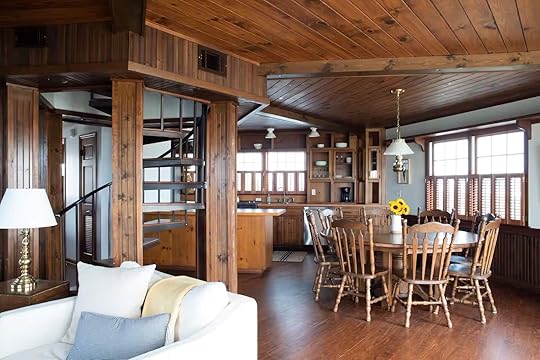 Photo: Airbnb
Photo: Airbnb Photo: Airbnb
Photo: AirbnbNorth of Jacksonville, Amelia Island is a stretch of Atlantic coastline that stays mild through the winter, with daytime highs that make the beach a year-round draw. Fernandina Beach is the hub, with historic streets, casual seafood spots, and easy access to the sand. The quieter vibe sets it apart from Florida’s bigger resort towns, and in winter it feels especially calm.
This beachfront lighthouse is just steps from the ocean at Fernandina Beach. The New England-style home has three bedrooms, a wrap-around deck, and uninterrupted views of the Atlantic Ocean.
Six guests, three bedrooms Price: $533 per night
Book NowLuxury retreat with rooftop deck and sunset views in Orange County, California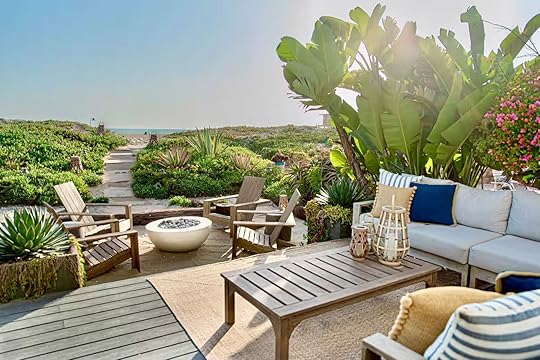 Photo: Airbnb
Photo: Airbnb Photo: Airbnb
Photo: Airbnb Photo: Airbnb
Photo: Airbnb Photo: Airbnb
Photo: AirbnbSee more photosTucked away between Huntington Beach and Seal Beach in a neighborhood dubbed “Sunset Beach,” this bohemian-feeling, peaceful seaside property was designed to give visitors a feeling of being transported to the tropical sands of Tulum. The stunning sunsets seen over the water will be breathtaking from each of the four levels to explore within this home that feels more like a resort.
Luxurious on-site at this property amenities include a Sonos sound system, a soaking bathtub, a bidet toilet system, a 3-car garage, and designer outdoor equipment, including beach bikes and bodyboards. Other amenities include a beachfront first-floor deck outfitted with a natural gas firepit and grill and enough lounge seating to fit everyone for an outdoor dining or stargazing session. There’s also a fully equipped kitchen with all the tools needed to create a tasty meal and three comfortable bedrooms — including a well-appointed primary suite.
Don’t miss the fourth-level rooftop deck, which is equipped with chaise lounges, a large sectional and 360-degree views—including the hills of San Pedro, the sparkling skyline of Downtown Long Beach, the Huntington Beach pier and Harbor, and, of course, the ocean.
Eight guests, three bedrooms
Price: $1,679 per night
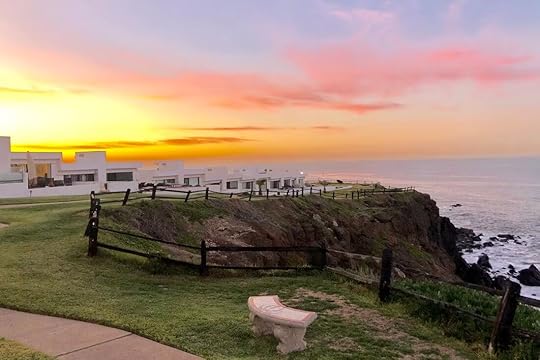 Photo: Airbnb
Photo: Airbnb Photo: Airbnb
Photo: Airbnb Photo: Airbnb
Photo: Airbnb Photo: Airbnb
Photo: AirbnbSee more photosThe crown jewel of this upscale, three-bedroom attached villa is likely the breathtaking ocean views from its enormous patio space overlooking the ocean. Listening to the sound of the waves below is the best way to relax within the recently remodeled, updated open-concept living spaces. Contemporary furnishings and amenities include high-speed internet access and a big flatscreen Smart TV in the living room. Cook in the modern kitchen, which features granite countertops, stainless steel appliances, and a water filter, in addition to a myriad of cooking tools and dinnerware.
The villa is a 5-10 minute walk from the festivities of downtown Rosarito, but peace and safety are paramount within the neighborhood due to a 24-hour security detail and gated community-only access. Other community-wide accessible amenities include a pool, sauna, spa and gym.
Six guests, three bedrooms
Price $185 per night
 Photo: Airbnb
Photo: Airbnb Photo: Airbnb
Photo: Airbnb Photo: Airbnb
Photo: Airbnb Photo: AirbnbSee more photos
Photo: AirbnbSee more photosTake the Californian chilled lifestyle, add a dash of European island vibes, and you get one heck of a combo. That’s Catalina in a nutshell. It reminds me of the South of France or the Amalfi, and with quick one-and-a-half-hour transfers from three ports in South California, it’s a lot easier for West Coasters to get to than Europe. There are two towns on the island, Avalon and Two Harbors. Those wanting to stay in Avalon will need to book in advance, even in winter. As you might expect, Airbnbs and other holiday rentals are a hot commodity.
This newly renovated cottage is beautifully decorated, and when you’re not at the beach club, you can chill in the spacious private outdoor yard and take in the views of the harbor. There are three bedrooms and two bathrooms, and the location is spot on. It’s a one-minute walk to the grocery store and three minutes to the harbor and restaurants.
Six guests, three bedrooms
Price: $1,036 per night
 Photo: Airbnb
Photo: Airbnb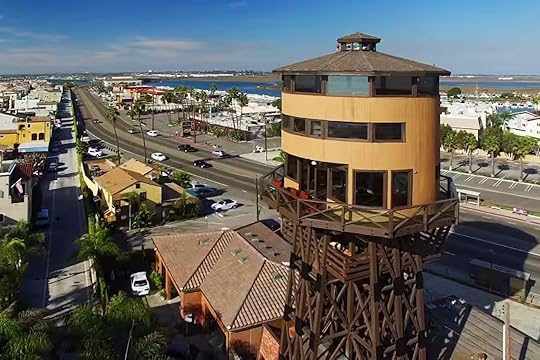 Photo: Airbnb
Photo: Airbnb Photo: Airbnb
Photo: Airbnb Photo: Airbnb
Photo: AirbnbSee more photosThis one-of-a-kind four-story, 87-foot Water Tower House is famed for its beautiful views and easy access to the local happenings of Seal Beach on the California coast. The structure itself dates back to 1892, initially serving as a source of water and power for Pacific Railway steam engines — but has since been converted into a home featuring three bedrooms, four baths, a family room, a dining area, and stunning views.
The elevator offers guests access to the first three levels. Up to the main level, admire the enormous windows with panoramic sights of the city and the scenery, and step out onto the wraparound deck, which has a jacuzzi. There’s a whimsical spiral staircase to reach the 4th and 5th Floors. The fully equipped kitchen has all the tools needed to make a yummy dinner, and the laundry facilities mean guests can extend their stay and keep fresh. The fifth floor features a well-appointed living room space with a bar, games, 360-degree views, and multiple Smart TVs for staying entertained any time of day or night.
Eight guests in four bedrooms
Price: $729 per night
 Photo: Airbnb
Photo: Airbnb Photo: Airbnb
Photo: Airbnb Photo: Airbnb
Photo: Airbnb Photo: Airbnb
Photo: AirbnbSee more photosThis tasteful, upscale oceanfront home sits on Hollywood Beach in Oxnard, a historically favorite spot for celebrities to relax in their beach home. But this personally customized house itself is brand new. The property sits right on the sand — and was completed in December of 2018, featuring luxurious amenities like an elevator, four 70′ inch smart TVs, and a master bedroom perched up on the third floor showcasing unobstructed, panoramic views of the water below.
Seemingly, every room in the house boasts an impeccable view of the ocean. Watch the waves roll in from the large windows looking out onto the water in the living room space, relax in the luxurious soaking tub in the master bathroom (which also features sights of the ocean), or get cozy on the couch in front of one of the enormous televisions. There’s a large kitchen with an island to gather around and share a meal, and balconies on each level of the home to enjoy the fresh sea air and sunshine.
Fourteen guests, five bedrooms
Price: $786 per night
 Photo: Airbnb
Photo: Airbnb Photo: Airbnb
Photo: Airbnb Photo: Airbnb
Photo: Airbnb Photo: Airbnb
Photo: AirbnbSee more photosFeel like royalty in this large villa property boasting sweeping ocean views, an enormous patio, three bedrooms and two and one-half baths. Lounge out on the spacious, private, shaded veranda, which has a gas barbecue and chaise lounges. Rest in one of the comfortable and stylishly furnished bedrooms. Share a meal at the dining room table, surrounded by glass windows featuring sights of the blue sky and ocean below.
There’s a large skylight in the kitchen, letting in an abundance of natural light, and the stainless steel appliances and sleek countertops offer a great spot to make a home-cooked meal. Additional on-site amenities include a cozy gas fireplace, central air-conditioning, a large flat-screen TV, and a relaxing jetted tub in the master bath.
Eight guests, three bedrooms
Price: $1,069 per night
 Photo: Airbnb
Photo: Airbnb Photo: Airbnb
Photo: Airbnb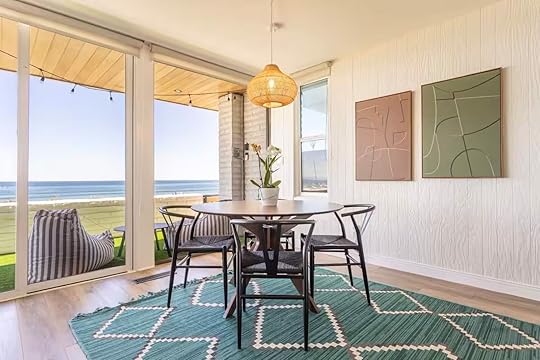 Photo: Airbnb
Photo: Airbnb Photo: Airbnb
Photo: AirbnbSee more photosThis clean, light-filled property is set on the iconic Strand in Manhattan Beach. Enjoy beautiful sea views and unparalleled beach access — just two elements that make this property feel exceptionally special. Gaze out the large windows onto the beach or step outside onto the balcony and breathe in the sea air.
Bright, modern design elements and a touch of vivid color in the furnishings add a bohemian flair to the otherwise minimalist decor. There’s a cozy living room with a large sectional, flatscreen TV, and a fireplace flanked by a wall of windows. The compact but functional kitchen has everything needed to make a home-cooked meal. It’s within walking distance of the sand and many shops and restaurants of downtown Manhattan Beach. 
Five guests, two bedrooms
Price: $512 per night
September 22, 2025
12 Ways to Beat Jet Lag (And the One This Travel Editor Swears By)
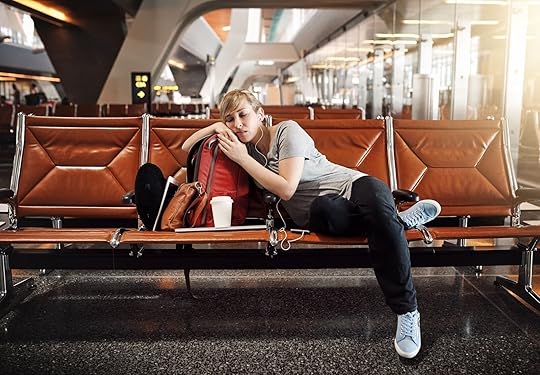
As a travel editor, I get a lot of questions about jet lag. How to avoid it, how to get over it, is the jet lag really worth it for a short trip — the list goes on. I’ve told people the same thing for years: just adopt the time zone that you land in and fight through the initial discomfort. I’m usually met with a response like, “Sure, that works for you, but I could never,” or a head nod with body language that clearly suggests they’ll be doing their own research.
My mom was the first to put that little nugget of travel wisdom into my travel routine. We flew from our home in California to Europe for two weeks, and my teenage mind couldn’t comprehend that my aversion to sleep was actually the right approach as I unpacked in a cheap Paris hotel with walls best described as spongy but not intrusively moldy. The jet lag hack worked well enough. Over the next decade and a half, I built a career that required me to travel to far-flung places at least once a month. And I lived, and still live, by that original advice.
In some circles, this is referred to as “clock blocking.” Meaning you set your watch (at least mentally) to the time zone you’re going to be in as soon as you get on the plane and live as if you’re in that time zone regardless of what’s going on around you. No prep, no expensive remedy, just some good old fashioned will power to get through it and not think about what time it is back home.
Am I often tired? Absolutely. But if you don’t do anything to make you tired, you’re not going to sleep well. I have yet to find another way to adjust as fast as adopting wherever the sun is when I land. Yet. My travel style has changed quite a bit since that first international trip — two kids in three years will do that. Toddlers don’t care one bit about what time the clock says or even all that much when the sun goes down, as I’ve learned in Japan, Türkiye, and just going to the East Coast from Denver.
I still stand by fighting through the tired and forcing myself to live in the time I land in. But in the interest of keeping options open, these 12 other ways to overcome jet lag could be your ticket to no wasted days no matter how far you go.
Adjust your schedule over time before you leaveThis one takes commitment — and a very flexible schedule before your trip even starts. It involves adjusting when you go to bed (and when you eat your meals for the truly dedicated) in 30-minute increments each day until you’re on the normal sleep hours of where you’re going. The Mayo Clinic suggests going to bed a full hour closer to your target time if possible, though the 30-minute recommendation seems more reasonable. Melatonin might help.
If you’re flying from Los Angeles to New York City, for example, start going to bed 30 minutes earlier each day for six days leading up to your flight. That’s if you’re going east. For flights west, go to bed 30 minutes later each day. If math isn’t your strong suit, a tool like Jet Lag Rooster can break out the timing for you. Bigger time changes require a bigger commitment, so this might be better for cross-country flights if those couple of hours really trip you up.
Coming home? Well, you could change your travel days to be back on your normal schedule when you get back, but more than likely you’re on your own.
Manage your light exposure
Photo: Serhii Ivashchuk/Shutterstock
The body’s circadian rhythm, the internal clock that regulates physiological responses like sleep, can be tricked by a simple light exposure adjustment. Light therapy is theoretically easy to do: avoid bright light when there won’t be bright light in your destination. It’s similar to the earlier bedtime hack, but doesn’t require a full sleep schedule shift. Researchers at Rush University in Chicago published a study that found bright light can cause predictable responses in your body. Simply expose yourself to bright light when you need to be awake in your destination, and stay in dark or dim light when you need to be asleep. Avoid the early morning light when going east and get your first dose of sun midday, for example. You don’t need any fancy equipment, but the options are seemingly endless if you want to dip your toes into that. There’s even a gadget out there that shines light into your ear canals.
What you do when you arrive is just as important. It might be the only thing you have time for, but all is not lost. If it’s sunny out when you arrive, simply go outside for a walk so your body can start to adjust. If it’s night, wear dark glasses and a sleep mask in transit. Light therapy devices as simple as a sunrise alarm clock can help control your light exposure if you want to be more precise.
MelatoninYou’ve most likely heard all about melatonin if you’ve ever been remotely interested in controlling your sleep. Researchers have known melatonin’s sleep-inducing effects since the 1960s when scientists were injecting 200 milligrams straight into test subjects’ veins. It now comes in mass-market, over-the-counter pill form sold at just about every drug store and supermarket you can think of. You also don’t need the massive quantities used in those early studies — one study found as little as 4 milligrams per day is effective after a few days, and taking more just makes you feel more groggy.
Since your body naturally makes melatonin, it’s a more natural way to get your sleep from a pill than a prescription sleeping pill or sedative. Melatonin has shown to be effective even when switching five or more time zones.
Using melatonin for jet lag is similar to natural sleep and light exposure, but with a little extra help. You’ll still need to set aside about a week for the adjustment for the best results, however. You can also use a low dose of melatonin at bedtime when you arrive to nudge your body closer to realizing it’s time to sleep.
Stay hydrated
Photo: Jaromir Chalabala/Shutterstock
Sure, this is generally helpful life advice whether you’re traveling or not. And staying hydrated technically won’t do anything for your circadian rhythm. It will make you feel better — and make it easier to adopt your new time zone as soon as you get off the plane. (Drinking plenty of water on a flight has its own benefits outside of overcoming jet lag.)
General guidance also cautions against alcohol and caffeine, which can both mess with your sleep and make you even more dehydrated. I love an airport bar and in-flight wine with dinner, however, so I usually go the route of hydrating a little more after a drink.
FastingYour gut controls a lot more than you’re probably giving it credit for. According to one approach developed with the United States military and intelligence forces in mind, controlling diet can also control jet lag. The Argonne Diet developed by Dr. Charles Ehret at Argonne National Laboratory was tested in a study published in Military Medicine in 2002 and follows a feast-fast plan.
Start four days prior to travel. Alternate days between eating as you normally would with a slight adjustment to a high protein breakfast and lunch paired with a carbohydrate-rich dinner, and days where you eat mostly fruits and vegetables for a total under 800 calories. Caffeine is only allowed on feast days between 3 and 5 PM. The final fast should end with breakfast time at your destination, which must be protein-rich. Or, go the less planned route and fast for 12 to 16 hours before breakfast time at your destination and start from there.
Eating kickstarts your circadian rhythm, the thinking goes, and can have a similar effect as changing your sleep schedule ahead of time.
Get activeLight exercise can be an ally in fighting jet lag, according to the Mayo Clinic. Get out for a walk as soon as feasible at your destination. Jet lag aside, this is also a great way to orient yourself and start to get familiar with a new place. In the daytime, you’re getting that circadian-setting sunlight, and in the afternoon or early evening it helps to push you through until bedtime.
Just avoid heavy exercise and go for a walk, light jog, or bike ride — studies suggest avoiding heavy exercise an hour or so before you’re trying to sleep. Nix this plan if you arrive late, of course, and get the exercise in the morning to feel more on schedule.
Nap, but at the right timesJet lag often leaves you tired at odd hours. Managing sleep in the first days is crucial. Long daytime naps when you arrive can be a problem, but a power nap for 15 to 20 minutes can give you a refresh (if you’re able to avoid the temptation of the snooze button), according to the Centers for Disease Control. Additionally, don’t nap too late in the day. That could throw off subsequent days as well as keep you up a little longer than you anticipate.
Grounding, earthing, and putting bare feet on bare earth
Photo: BLGKV/Shutterstock
You probably fell into one of two camps the second you read “grounding, earthing, and putting bare feet on bare earth.” There are people who think it’s all woo-woo, and those who swear that connecting with the earth this way is the key to happiness. But even the latter camp has to admit that even if it’s all in your head, placebos can have an effect.
The name here is pretty self explanatory, particularly if you’re familiar with the likes of Gwyneth Paltrow and others in her sphere of influence. Earthing is centered on the idea that when people stand on the earth with nothing in between — no shoes, no socks, no sidewalks — we absorb electrons and stabilize our bodies. Touch grass, in the most literal sense. There’s no serious science to back this up, but then again, you’re also getting sunlight and relaxation when strolling barefoot in a new locale, so there’s that.
AromatherapyTaking a big whiff of the right smells might not “cure” jet lag, but it can help reset your mood. Terpenes from certain plants used in essential oils can have invigorating or calming effects. The citrus terpene limonene and the mint terpene menthol, for example, can be stimulating, while linalool (the most prominent terpene in lavender) is known to be a relaxing sleep aid. Terpenes have been a big area of research in recent years for how they can impact physiological functions as well as mood.
You can buy the fanciest essential oils your budget allows to follow this jet lag hack, or you can DIY it by finding the natural plants rich in those terpenes. For energy and alertness, consider peppermint, eucalyptus, lemongrass, and rosemary. To wind down, look to lavender and chamomile.
AcupressureAcupressure works by stimulating specific points on the body, known as acupoints, which are believed in Traditional Chinese Medicine (TCM) to lie along pathways of energy flow called meridians. Pressure on specific points in the body, according to acupressure believers, can restore balance (and unlike with acupuncture, which you almost certainly should not be trying on yourself, acupressure only requires your fingers or a blunt object like a pen). The goal is to use those pressure points to control your sleep, alertness, and digestion to encourage your body to align with a new time zone.
Dr. John Amaro is credited with popularizing using the body’s meridians to fight jet lag. By tricking your body’s meridian cycle to match the time in your location, you can force yourself to run on a new schedule.
If you’re interested, this is one you’ll have to contact your local acupuncturist for more on.
PycnogenolMelatonin gets all the love, but there are other natural supplements that research has found to be effective. A 2024 study on an extract from French maritime pine bark trademarked as Pycnogenol looked specifically at jet lag and post-flight recovery. Participants included healthy travelers, frequent flyers, aviation professionals, and a subgroup with mild hypertension. Those taking 150 mg of Pycnogenol daily before and after long eastbound flights (10 to 12 hours) were compared with controls who did not supplement. Outcomes measured included jet lag symptom scores, number of nights with disturbed sleep, cognitive performance, and physical signs such as ankle swelling.
The results showed that Pycnogenol users experienced significantly fewer and shorter-lasting jet lag symptoms, reported better sleep quality with fewer disrupted nights, and maintained higher post-flight cognitive performance compared to controls. One study is not the final word, but if you’re open to trying earthing or melatonin this shouldn’t be off the table.
Take a hot bathHot water baths and saunas can be a gentle way to ease into a new sleep schedule. Immersing yourself in warm water — whether that’s a hotel bath tub or a world-class sauna — raises your core body temperature. When you step out, the gradual cooling mimics the body’s natural nighttime temperature drop, signaling to your circadian system that it’s time to rest.
Beyond sleep benefits, hot baths and saunas also relieve the physical strain of travel. They soothe sore muscles and improve circulation after long flights — factors that can compound jet lag fatigue. While there’s little-to-no direct scientific evidence that heat therapies realign circadian rhythms, the combination of muscle relaxation, improved sleep onset, and cultural ritual makes them a low-risk, comforting strategy that can help ease jet lag symptoms.
At the end of the day, it’s your trip and you can make it what you want. Just try not to miss a day because of fatigue. You only get so many trips, after all. 
Lost Luggage? Here’s How Travel Insurance Can Save Your Trip
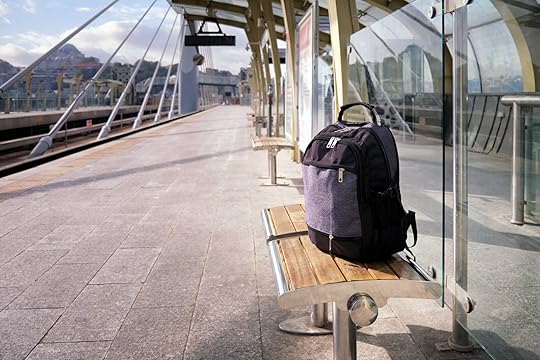
Nobody wants to be the last one at the baggage carousel only to find out their luggage never made it. Filing an insurance claim for lost luggage sounds daunting, but the process is pretty straightforward – and the more organized you are before you leave home, the better (and faster) the process is likely to go. Travel insurance policies can help with even small claims related to a lost or delayed bag.
Here’s what to know, what to track, and how to prepare so that you don’t come home with less than what you started with.
Matador Network has partnered with World Nomads to bring you the best info and rates on travel insurance policies. We may receive a commission from links on this page
Browse World Nomads PoliciesProper planning prevents poor performance
Photo: Garun .Prdt /Shutterstock
The mantra that proper planning prevents poor performance is commonly uttered in the outdoor community, and it applies with equal relevance when packing for a big trip. No one wants to deal with even the thought of losing a bag, but that’s the entire point of insurance. To ensure your travel insurance policy works when you need it, make notes of what you’re packing in each bag or suitcase. This may be simple to recall for a quick trip with just a carry-on, but if you’re checking multiple bags – particularly if headed on an expedition-style trip or otherwise traveling with a lot of gear – a diagram or list in a notebook or a doc on your computer should do the trick. This can be submitted with your claim if requested.
The good news is that insurers handle lost baggage claims every day, and the reimbursement process is generally straightforward (you’re not the first person to lose a bag). Gather your policy number, boarding pass info, baggage tags, and any reports you’ve already filed with the airline (such as a Property Irregularity Report). If items were stolen, a police report is usually required, and receipts or photos of what was lost will help support your claim.
“In general, the contents of your luggage will be covered (up to plan limits) with exclusions,” Terra Baykal, US editorial director at World Nomads, tells Matador. “These exclusions include things like household furnishings, prescribed medications, keys, and dentures.”
World Nomads and most major travel insurance providers require the policyholder to provide proof of loss within 90 days or as soon as is reasonably possible. No need to wait that long if you don’t have to – file as soon as you can for faster processing.
Browse World Nomads PoliciesLost luggage claims are more common than you’d think – and should be part of your policy shopping
Photo: Dizfoto /Shutterstock
Before choosing a travel insurance policy, examine the details of its baggage coverage. Start by checking both the total limit and per-item maximums, especially if you plan to travel with high-value items like laptops, cameras, or jewelry. Many base policies cap reimbursements at modest amounts, so you may need to buy additional coverage or declare valuable items in advance. Many base policy plans cap payouts at just $500 to $1,000, while mid-range and premium policies typically range from $1,500 to $5,000. World Nomads policies, for example, generally cover $1,000 to $2,500, with sub-limits—often around $500—for electronics.
It’s also wise to understand how “baggage delay” is defined. Most insurers specify how many hours your bag must be missing before coverage begins, as well as which expenses qualify for reimbursement. You’ll also want to look closely at exclusions and claims processes. Policies vary in how they define theft or loss, with many excluding unattended baggage, items stolen from vehicles, or adventure gear unless you add special coverage.
Ask how depreciation is handled with the insurance you’re using, since older items may only be reimbursed at reduced value. Clarify whether the policy acts as primary coverage or secondary to what airlines, credit cards, or homeowners insurance provide. Finally, review documentation requirements, including police reports, airline forms, receipts, and filing deadlines. Knowing these details upfront ensures you won’t be caught off guard if your luggage is lost or stolen.
Browse World Nomads PoliciesKeep an eye on exclusions – and fine print
Photo: Shine Nucha /Shutterstock
What you don’t see is just as important as what you do see in your travel insurance policy. Most plans set strict limits, including both a total payout cap per trip and a per-item maximum that may leave travelers underinsured for high-value belongings like electronics or jewelry. Some plans also require you to pay a deductible (or “excess”) before benefits kick in. Before you rush out to buy a new pair of Airpods, keep in mind that baggage delay coverage usually only applies after a set threshold of time — often 12 hours or more — and only for essentials you purchase while waiting, with receipts required.
“Think things like a toothbrush, pajamas, a change in outfit,” Baykal says. “If your bag never comes, you may be reimbursed up to the maximum benefit amount for the items that were lost (keeping in mind the exclusions). Included in all our plans is a baggage tracking and delivery service which can expedite the return of your missing bag.”
To take advantage of this, Baykal says, all travelers must do is report the bag missing to the airline for an official report, and then input the details when asked during the claim process. The policy holder takes it from there, working directly with the airline to find and return your bag.
If your bag is eventually returned with your original items inside—for example, your headphones—you may not be reimbursed for replacements, since those aren’t considered “necessities.” Insurers also generally won’t classify a bag as permanently lost until the airline or carrier officially declares it unrecoverable. Policies typically break it down as follows:
Delay: Reimbursement for essential personal items (such as clothing and toiletries).Permanently lost: Coverage up to the maximum policy value, adjusted for depreciation.Valuation: Payment is the lesser of the item’s actual cash value or the cost to repair or replace it with a similar item.Another critical detail is that baggage coverage is usually secondary, meaning payouts are reduced by what airlines, credit cards, or homeowners or renters insurance already cover. Keep an eye on exclusions: unattended or unsecured items, losses due to negligence, normal wear and tear, or theft from a locked vehicle may not be covered. Professional equipment, sporting gear, and very expensive personal property may require separate add-ons.
Travelers must also meet documentation requirements, such as filing a Property Irregularity Report with an airline, submitting police reports for theft, and providing receipts or proof of ownership. Claims often must be reported quickly (despite the delay period you may have to wait to see if the bags turn up), so keeping paperwork organized is essential to avoid losing out on a reimbursement.
Browse World Nomads PoliciesWhat to do when you need to file a claim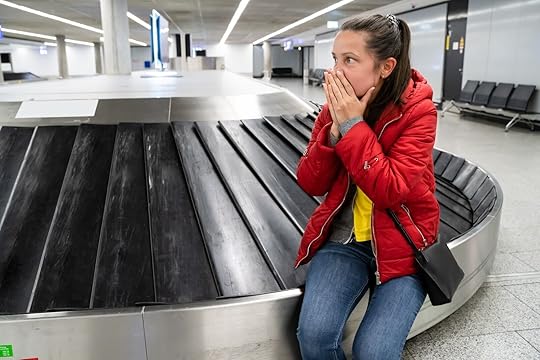
Photo: Andrey_Popov/Shutterstock
Before filing a claim, dig through your receipts. Anything you can document will make the claims process faster and will help you get as close as possible to the actual value of what was lost.
“Original receipts are the best way to prove the value of what was lost,” Baykal says. “If you don’t have these, the value will be determined by the claims team. In both cases, depreciation will be taken into account. This means that if you’ve lost an old phone, you won’t be paid out the value of a new phone. Your travel insurance plan is meant to make you whole (replace what was lost), not score you a free new phone.”
With your policy number, boarding pass info, baggage tags, and any reports you’ve already filed with the airline in hand, the process of getting reimbursed becomes a matter of sharing details you already know: where you traveled, what was lost, and when it was reported. Most insurers allow claims to be filed online, which lets you move at your own pace and check things off one at a time. Once submitted, claims are typically reviewed within a couple of weeks, though payment may take up to 30 days depending on the insurer.
Losing your baggage is an undeniable case of “the suck” – but having a travel insurance policy that can at least get you back to where you started is a sound investment. 
Smile: AI Analyzed Whether You Really Enjoyed That Family Beach Vacation

If you thought the perfect beach selfie was just about finding good light and the right angle, think again. New research from Beach.com claims to have found the happiest beach towns in America, and it didn’t take into account factors like weather, size of the beaches, or even hotel reviews. Instead, it analyzed your beach vacation photos. Or, to be more exact, 100,000 beach photos.
It’s one of the more unique (or at least quirky) uses of AI. Researchers found 1,000 location-tagged beach photos from Instagram from 100 different beach towns in the US. They then fed those into an emotion-recognition software called DeepFace, which it claims can recognize seven distinct emotions: anger, fear, neutral, sadness, disgust, happiness, and surprise. The researchers were able to determine “both how often people appeared happy in the photos and how certain the AI was about those smiles.” This allowed them to create a “happiness score” between one and 100 for each town.
By the way, if you assumed towns in Hawaiʻi must have topped the list, think again: none were included. Despite the state having plenty of beach towns, researchers only considered the top 100 beach towns with populations under 250,000 using Census Bureau data, which isn’t fully collected across the Hawaiian islands. So if you suspect Hawaii’s beach towns are the happiest in the world, you’ll just have to go see for yourself.
The happiest beach town in America
Photo: Sean Pavone/Shutterstock
Posted recently about Charleston, South Carolina? Whether you had a great time, or just managed to fake a smile during your family reunion beach trip, it worked, because Charleston took the top spot for the happiest beach town in the country. That said, there’s a lot to smile about in Charleston, a beach town with pastel houses, cobblestone streets, beaches within a quick drive, and she-crab soup. The AI analyzed 1,060 faces from photos, and found that 606 had “dominant expressions of happiness.” One can only imagine what the other 454 faces analyzed were going through — perhaps they were asked to sweat though linen suits at an August wedding, or made the mistake of trying to drive a huge SUV for the whole family through Charleston’s historic, narrow streets.

Photo: Jeffery Edwards/Shutterstock
The second-happiest beach town in America is supposedly Mount Pleasant (a little too on-the-nose, no?). It’s just a quick drive from Charleston and known for seafood shacks, marsh views, and easy access to Sullivan’s Island. It earned a happiness score of 50.2, just a few points below Charleston’s 54. Without too many details, it’s hard to definitively say why it scored so high — though the fact that it offers access to Charleston without the prices of Charleston’s boutique hotels could have something to do with it.
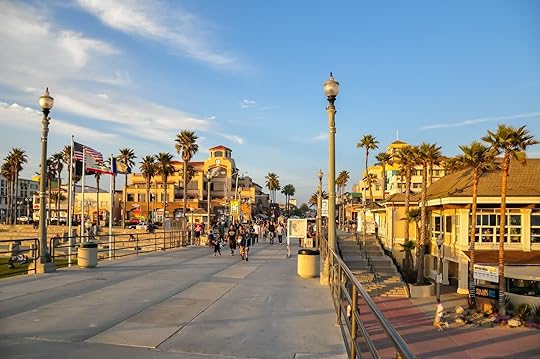
Photo: Moab Republic/Shutterstock
The third and fourth locations where people look happiest on the beach were both in California: Huntington Beach and Newport Beach, respectively. Huntington Beach, also known as “Surf City, USA” didn’t just score high for happiness. It also scored highly for “most expressive” faces, suggesting that the look on a surfer’s face after riding the perfect wave is one of pure happiness (or that plastic surgeons around LA are doing a great job). Carlsbad, California, was the only other West Coast beach town to come out in the top 10 — perhaps because visitors didn’t have to leave their dogs at home?
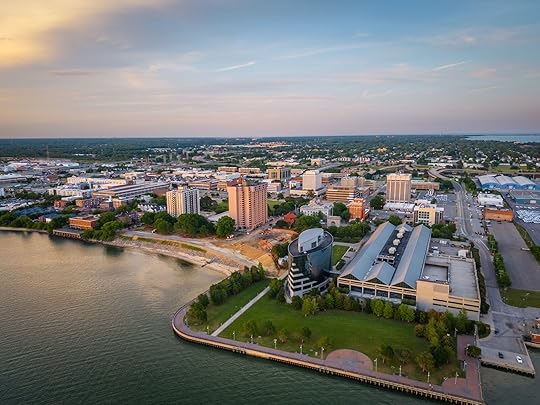
Photo: Sean Pavone/Shutterstock
Poor Newport News. Out of the 100,000 beach photos analyzed, this Virginia Beach town had the lowest happiness score, at 23 out of 100. Unlike Charleston or Huntington Beach, Newport News isn’t really built around leisure. Instead, most of its shorelines are dedicated to shipyards and naval facilities. While that keeps the town’s economy humming, it does leave fewer places to experience summery, beach bliss. However, Newport News is on the James River and isn’t too far from the Chesapeake Bay, giving it plenty of beach- and water-focused offerings, even if it doesn’t have a billboard-ready tourist waterfront.
For the full list of rankings, visit the Beach.com report. 
Travel by Land, Sea, or Sky, and Let The Infinite Coast in British Columbia Inspire Your Adventure

Just outside of Vancouver in British Columbia, ocean, rainforest, and mountains blend into a region best explored slowly and intentionally on The Infinite Coast. Summer means long days spent sailing with sunlight lasting late into the evening. Fall yields world-class wildlife-viewing, whether you’re on the lookout for whales or bears. Winter spells magically moody landscapes and coastal storm-watching that will guarantee you never look at the sky the same way again.
Stretching from the Salish Sea in the south to the lush, rain-fed inlets of the Great Bear Rainforest to the north, the British Columbia coast is an area that demands total attention, with some areas only accessible by boat, floatplane, or on foot. It’s a place where geography shapes both ecology and culture, where you can stand under the canopy of old-growth rainforests, be awed by some of the most powerful creatures in North America, and follow where water and land converge while traveling along the Inside Passage. The rewards are remote wilderness and Indigenous experiences unique not just in BC but in North America.
Most trips to The Infinite Coast start in Victoria. From there, you can travel by ferry through island-dotted passageways to waterfront communities on Vancouver Island or connect to the Sunshine Coast via a combination of ferry routes and scenic drives. Traveling on the water immediately makes trips here slower and more deliberate, allowing you to watch, listen, and pay attention to the rhythms of the natural world.
Escape to where the forest meets the sea…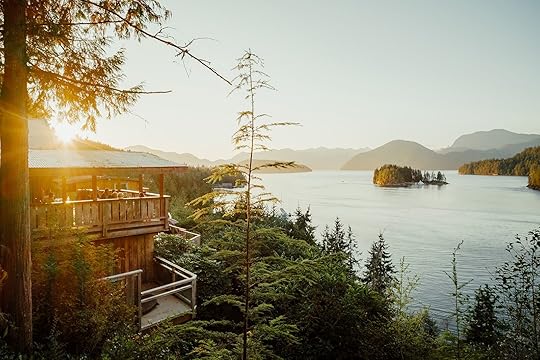
View of Sechelt Inlet from West Coast Wilderness Lodge in Egmont. Photo: Destination Canada
Despite being on the mainland, you can’t drive directly to the aptly named Sunshine Coast. Instead, plan to board a ferry, arrange a private boat, or opt for a seaplane. Its isolation gives the area an island-like feel and helps to preserve its tranquil atmosphere.
Once you arrive, the Sunshine Coast feels worlds away from city life. The laid-back pace, cedar forests, and oceanfront communities like Gibsons and Sechelt blend art, nature, and wilderness. Orcas and seals are common sights in Sechelt, and attractions like the shíshálh Nation’s tems swiya Museum and the Tsain-Ko Native Gifts & Art shop pay homage to the area’s deep Coast Salish Indigenous roots.
…and follow quiet inlets to solitude.
Kayaking on Desolation Sound. Photo: Destination BC / Andrew Strain
To reach the northern Sunshine Coast, take a scenic ferry ride to Powell River, a gateway to some of the most unforgettable adventures in the region. Just beyond lies Lund, a quiet harbor town with a bakery, tour operator, and place to stay: The Lund Resort at Klah ah men. This also puts you close to one end of the roughly 112-mile Sunshine Coast Trail, which stretches through remote forests and alpine ridges from Sarah Point on Desolation Sound all the way to Saltery Bay and the Jervis Inlet. Many sections are accessible for pleasant day hikes, with coastal views and picnic-friendly rest stops for a gentle introduction to the terrain. If hiking’s not on your itinerary at all, you can still reach Desolation Sound from Lund by boat, water taxi, or kayak.
Desolation Sound may host the largest marine park in BC, but it’s an oasis of solitude. When you get there, spend days paddling between emerald bays, camping on rocky outcroppings, and falling asleep to the sounds of sea lions barking in the dusk. You’ll want to take your time, both to conserve energy and appreciate the surroundings — the fjords stretch inland for miles. On land, you might spot black bears navigating the gravel beaches. In the water, orcas reign supreme. Experienced paddlers can plan their own adventures, while guided trips are available out of places like Lund and Powell River.
For an elevated perspective (literally), consider a flightseeing tour of the area. Scenic flights over Desolation Sound and the neighboring fjords yield bird’s-eye views of its sheltered coves and island-dotted waters — ideal for travelers seeking a refined way to connect with nature. In Campbell River, 49 North Helicopters runs both flightseeing and adventure tours that showcase the dramatic beauty of Desolation Sound from above.
Journey where trails, traditions, and tides converge.
Tofino, Vancouver Island. Photo: Destination Canada / Brian Caissie
Across the Strait of Georgia from the Sunshine Coast and Desolation Sound lies Vancouver Island, a destination that wows on arrival. Stop in Campbell River and set out in search of humpbacks, orcas, or grizzlies with Homalco Wildlife & Cultural Tours (offered seasonally from May to October) while learning about the deep connections that the Homalco First Nation have to this land and sea. After a day on the water, retreat to Naturally Pacific Resort, a luxurious coastal hideaway where modern suites, a full-service spa, and locally inspired cuisine at Carve Kitchen & Meatery ensure you end the day on a high note.
On the west coast of Vancouver Island lies Tofino, a world-renowned surf town where powerful waves meet vibrant arts and culture, and wildlife viewing opportunities abound. On the edge of town, the Tonquin Trail provides rainforest and coastal views and is a serene way to experience the natural beauty that defines the region. To meaningfully connect with the landscape through Indigenous knowledge, consider a culturally immersive tour with Ahous Adventures, owned and operated by the Ahousaht Nation.
Also in the area is Tla-o-qui-aht Tribal Park, an Indigenous-led conservation initiative. Encompassing four protected areas, the park includes tidal estuaries; wave-pounded beaches; wildlife-rich forests essential for migrating birds, wolves, and cougars; and ancient rainforests. Rooted in the Tla-o-qui-aht Nation’s principles of sustainability, these lands are a living expression of resistance, resurgence, and responsibility. Visitors can explore the park in respectful partnership with local guides and businesses who support the Nations Tribal Park Allies Program — enjoy river paddling adventures, cultural interpretation experiences, and a guided hike to a coastal First Nations Village.
Boutique hotels in town are the perfect place to experience the famous storm-watching during the late fall and winter months. Properties such as the Wickaninnish Inn, Black Rock Oceanfront Resort, and Best Western Plus Tin Wis Resort allow you to take in the dramatic coastal weather from the comfort of your suite. In nearby Ucluelet, you’ll find a different testament to nature at Pluvio Restaurant, where artfully crafted tasting menus turn seasonal ingredients into a show that unfolds right on your plate.
Enter the realm of the Spirit Bear…
Spirit Bear on Great Bear Rainforest. Photo: Destination BC / Yuri Choufour
Traveling north, set your sights on the expansive, lush, and otherworldly Great Bear Rainforest. Getting there is half the experience — think floatplanes and remote drives through moss-draped forests — but the towering old-growth forests, salmon-fed ecosystems, and elusive white-furred Spirit Bear that await are well worth the journey.
The Spirit Bear is a subspecies of the American black bear, about 10 to 20 percent of which are born with a recessive trait that gives them cream-colored fur. Their home in the Great Bear Rainforest is Indigenous territory — a region stewarded by coastal First Nations, including the Gitga’at and Kitasoo Xai’xais, who hold deep cultural and spiritual connections to the land and its wildlife. Salmon, in particular, are the lifeblood of this area, nourishing not only the bears, wolves, and whales that call it home but also sustaining the ways of life, economies, and identities of those who’ve lived here for generations.
Spirit Bear Lodge not only offers access to this wonderfully remote region but also immersion into a broader network of Indigenous-guided experiences that honor the ecological and cultural significance of the rainforest. Exploring the area with a First Nations guide is a chance to learn the ancient knowledge of the land while keeping an eye out for the rare bears, seen as guardians of the forest and liaisons to the spirit world. Humpback whale, sea lion, and other wildlife sightings round out the experience in the Great Bear Rainforest, making each day on the water or trail a journey through one of the richest coastal ecosystems in North America.
…and go where grizzlies rule.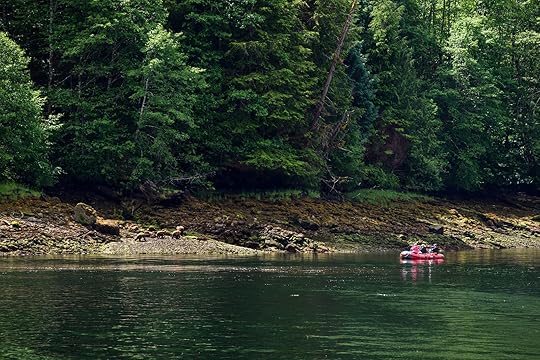
Grizzly watching in the Khutzeymateen Grizzly Bear Sanctuary. Photo: Destination BC / Andrew Strain
Your wildlife adventures continue as you head farther north to one of the most remote places in North America: the Khutzeymateen Inlet and Khutzeymateen Grizzly Bear Sanctuary, the sole designated grizzly preserve in Canada. It’s accessible primarily by water from Prince Rupert.
In the sanctuary, small boats allow for low-impact viewing of bears in their natural habitats — be prepared for hours spent floating in silence, eyes peeled for the gorgeous animals. Because this sanctuary is protected and remote, one of the best ways to visit is by booking a package that includes your transportation and guides.
No single itinerary can capture the inexhaustible list of wonders on The Infinite Coast. Its ribbon-like network of waterways, airways, and roads means each traveler has the chance to build out their own adventure. Some will follow ferry routes up the coast, moving island to island on a whim, while others will opt to base themselves at a single outdoor-focused lodge, deciding each morning whether they want to explore on foot or by canoe. Some will come for the wildlife, some for the weather, and some to do nothing but sit and lean against the trunk of a 1,000-year-old cedar tree. The draw of The Infinite Coast isn’t one activity or one attraction — it’s immersing yourself in the varied nature of the coast as a whole. 
Rainforest to Rockies in British Columbia Is Your Gateway to Ever-Changing Landscapes

The coastal, mountainous Canadian province of British Columbia is one of the most gorgeous regions in all of North America, with everything from lush rainforests and alpine glaciers to dramatic, snow-capped peaks that hide secret waterfalls. For Californians, it’s reminiscent of the Sierra Nevada — if the Sierra Nevada’s peaks ran from sea level to more than 13,000 feet high and were covered in year-round glaciers and roaring rivers churning over boulders the size of houses. As if that wasn’t cool enough, there are also enormous ferns and trees that are so striking they almost seem prehistoric.
For adventurers looking to explore the beauty of BC, there’s no better journey for witnessing the ever-changing diversity of landscapes than Rainforest to Rockies. It’s a 440-mile drive from Pacific-side Vancouver to Mount Robson, the tallest summit in the Canadian Rockies. Along the way, rainforest, alpine, and canyon country unfolds in seamless succession, each landscape more dramatic than the last. Here’s how your BC journey can play out.
From ocean views to soaring above sea level
Prince of Whales whale watching tours. Photo: Destination Vancouver/Prince of Whales Whale Watching
From California, the easiest way to explore this section of BC is by flying (or driving, if you’re so inclined) to Vancouver, where nature and urban life are inseparable. Two must-sees in the province’s biggest city: Capilano Suspension Bridge Park’s swaying bridge over a rushing canyon and rainforested Stanley Park’s cedar-lined Seawall pathway. This biking and walking promenade provides stellar views at every turn, along with a chance to spot curious harbor seals and other marine wildlife.
One of the most unique ways to get to know the natural side of Stanley Park is on a tour that centers the First Nations perspective, like those from Indigenous-owned Talaysay Tours. The daily Talking Trees tour helps guests learn how Indigenous Peoples have lived off the land around Vancouver for millennia.

Sea-to-Sky Highway near Horseshoe Bay. Photo: Destination BC/Hubert Kang
Leaving Vancouver and heading north along the Sea to Sky Highway, the road winds along the edge of spectacular Howe Sound, the most southerly fjord in North America. The drive to the climbing- and mountain-bike-friendly town of Squamish has nonstop views of mountains plunging into turquoise waters, often with bald eagles soaring overhead.
In Squamish, the Sea to Sky Gondola whisks visitors to 2,903 feet above sea level for views of glaciers and ridgelines (though ambitious visitors can hike their way up, too). At the summit, the Sky Pilot Suspension Bridge offers a breathtaking walk — an exhilarating way to take in the dramatic landscape.

Sea to Sky Gondola. Photo: Destination Vancouver/Sea to Sky Gondola/Paul Bride
Squamish’s lively charm — paired with eight provincial parks, craft breweries, and artisan bakeries and coffee shops — makes it an ideal stop for at least one evening. For a rainy afternoon, the nearby Britannia Mine Museum provides a chance to enter a former working mine and see how the industrial heritage buildings have been modernized and restored.
From the ultimate alpine town to a cultural hub
What We Treasure tour at Squamish Líl̓wat Cultural Centre. Photo: Squamish Líl̓wat Cultural Centre/Logan Swayze
The landscapes shift again as this journey climbs into the alpine town of Whistler. Known for world-class skiing in winter, fall in Whistler means meadows flanked by autumnal hues, evergreen forests with carpets of moss, and hiking and biking trails for every ability level. The pedestrian-friendly Whistler Village is polished yet outdoorsy, and visitors can enjoy ziplines, rafting, gourmet tasting menus, organic spa services, and more — often all in the same day.
Importantly, Whistler lies on the traditional land of the Sḵwx̱wú7mesh Úxwumixw (Squamish Nation) and Líl̓wat Nation, and their cultures are beautifully represented at the architecturally stunning Squamish Líl̓wat Cultural Centre, whose design is a contemporary take on First Nations structures.
Beyond Whistler, the route turns inland, trading lush rainforest for the rolling hills and arid canyons of interior BC. Whistler to Kamloops is about a four-hour drive, making midway-point Marble Canyon Provincial Park an excellent detour. The canyon’s mineral springs and unique rock formations are a reminder that, popular as it is, Rainforest to Rockies rewards those who slow down and step off the main road.
In Kamloops, where two rivers meet in a broad valley, you’ll find a town dotted with galleries and opportunities for farm-to-table dining. The transformation of the landscape since leaving Vancouver is striking — what began as rainforest now feels almost desert-like, highlighting the astonishing diversity of BC.

Scenic view of Downtown Kamloops. Photo: Destination BC/Tanya Goehring
Towns like Squamish, Whistler, and Kamloops aren’t off the beaten tourist track, but part of their appeal lies in their role as hubs for exploring the many natural landscapes of BC (of which there are many). It’s possible to travel from one town to the next by car in no time — Whistler and Squamish are less than an hour apart — but every mile or so, you’ll find a new trailhead, turnoff, or viewpoint. It’s worth leaving yourself lots of time for each leg of the drive.
From waterfalls and volcanoes to epic peaks
Helmcken Falls. Photo: Destination BC/Max Zeddler
Visitors who feel like California’s mountain towns have become too crowded will love Clearwater, especially as the small town is the gateway to Wells Gray Provincial Park. It’s a vast wilderness playground of waterfalls, mineral springs, and extinct volcanoes, best described as raw and untamed. Here, Helmcken Falls plunges more than 450 feet into a misty gorge and is certainly the main draw, but dozens of other cascades and picturesque trails meander through the rugged Cariboo Mountains, past jagged peaks and steep canyons, and into fir and spruce forests.
Clearwater is also noteworthy for its topography and is dominated by one dramatic feature: volcanoes. The town is home to a massive volcanic field with not one, not two, but a whopping 22 volcanoes. Spend a little extra time in Clearwater, and you’ll be able to climb atop a volcanic hill at Pyramid Mountain (6 miles, 1,070-foot gain) and get a bird’s-eye view of fantastic fall foliage from the Flat Iron Trail (5.5 miles, 1,110-foot gain). Also off the beaten path — but not by too much — is Dragon’s Tongue, the dark black remains of a lava flow caused by the eruption of nearby Dragon Cone about 7,600 years ago.
After visiting Clearwater, wildlife surprises abound, from bears to bighorn sheep, as you travel toward one of the most impressive natural features in BC: Mount Robson. The peak has a vertical prominence of over 10,000 feet, meaning it absolutely towers over the landscape. And unlike the more traversed mountains of the Sierra Nevada, Mount Robson’s surroundings are remote and uncrowded — and home to massive hanging glaciers and thundering waterfalls. Fit hikers can climb Mount Robson in two days, but with so much beauty along the trail — from waterfall-filled canyons to wildflower-covered meadows — you’ll want to take your time (and lots of photos).

Hiking in Mount Robson Provincial Park. Photo: Destination BC/Megan McLellan
From Mount Robson, it’s easy to return to Vancouver by driving south from Kamloops, where trails close to the cities of Hope, Chilliwack, and Abbotsford offer a multitude of ways to get out and enjoy the views. However you choose to wrap up your trip to BC, brace yourself: Rainforest to Rockies packs in more scenery and cultural experiences than you might’ve encountered in a single region ever before — and that can make leaving the province pretty darn difficult. 
Let Nature Nurture You in the Valleys & Vineyards of British Columbia
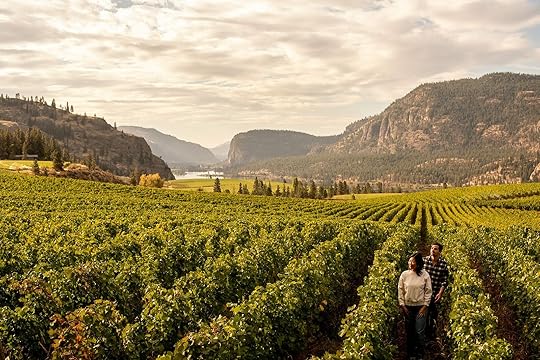
In Valleys & Vineyards, nature leads the way. Golden hills roll into lush valleys, volcanic soil breathes life into orchards and vines, and Indigenous stewardship sets the tone for respecting the terrain. Here, every glass, plate, and path tells a deeper story.
As you travel over the Coast Mountains, moving east from Vancouver, the landscape in British Columbia changes dramatically. You leave behind the coastal rainforest and enter the drier, sunnier Okanagan Valley, with more than 200 wineries set among rolling hills above a chain of lakes. Autumn is harvest time in the valley, when the summer heat abates and the fields buzz with hard work and anticipation, making it the perfect season to enjoy its bounty.
Valleys & Vineyards may be new to UK travellers, but it represents a region that’s long been connected to nourishment for both soil and soul. From vineyard visits and fine dining to bike trails and paddling on the many lakes, an autumn trip here promises wellness in every sense of the word.
Getting to know the Okanagan Valley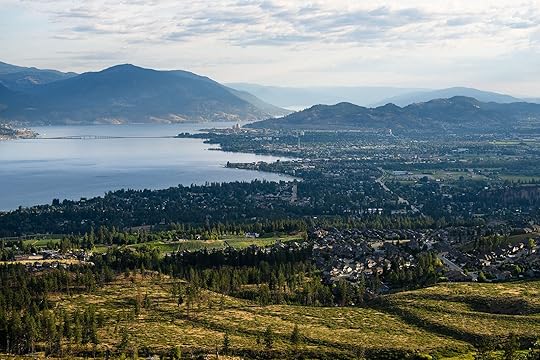
Kelowna Mountain overlooking Okanagan Lake. Photo: Destination BC / Andrew Strain
Running through the interior of BC and centred on the city of Kelowna, the Okanagan is divided into three general areas: the temperate North Okanagan, where lush farmland and scenic drives set the pace; the lake-rich Central Okanagan, where urban sophistication meets hillsides dotted with wineries; and the semi-arid South Okanagan, where orchards and vineyards thrive under big skies.
Each is flush with stops worth making. In the North Okanagan, for example, there’s Vernon, a lakeside community known for its clear waters, outdoor spas, and access to tranquil trails where you might come to recharge. The Central Okanagan plays host to the largest population hub in the area, Kelowna, which is positioned on the shores of the 84-mile-long Okanagan Lake, the main body of water in the region. Wineries surround its urban core, unfurling through the idyllic hillside landscape along the lakeshore. Penticton, in the South Okanagan, sits between Okanagan Lake and the smaller Skaha Lake, and the four dozen vineyards and wineries of the Naramata Bench are just beyond the city.
Elsewhere in the South Okanagan, towns like Osoyoos and Oliver centre around the warmest freshwater lake in the country, Osoyoos Lake. Top wineries in this subregion make up the Golden Mile Bench, and the Similkameen Valley communities of Keremeos (the Fruit Stand Capital of Canada) and Cawston (the Organic Farming Capital of Canada) highlight the broader agricultural heritage in the Okanagan.
Sampling the bounty of vineyards and orchards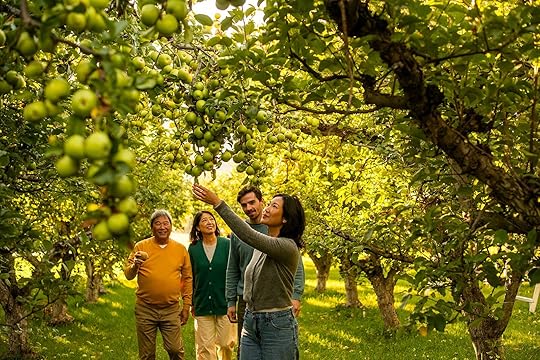
Klippers Organics in Cawston. Photo: Destination British Columbia
In a place as fertile and life-giving as Valleys & Vineyards, it’s no surprise that sustainability influences the regional winemaking. With wineries like Noble Ridge Vineyard and Winery in Okanagan Falls, which is leading the way as Canada’s first Biosphere-certified winery — a globally recognised sustainable tourism standard — wine producers throughout the Okanagan have adopted organic, sustainable practices and produce a variety of wines to sample. Another biodynamic winemaker, Kelowna’s Summerhill Pyramid Winery, ages its organic wines in a pyramid cellar and offers tastings that sometimes include ice wine, a sweet dessert wine produced when grapes freeze on the vines.
Visit Checkmate Artisanal Winery — situated in a striking modern vineyard-view building — for several guided tastings, including the Grandmaster’s Table Experience where you’ll try a curated selection of chardonnays and merlots paired with small bites. At Nk’Mip Cellars, the first Indigenous-owned winery in North America, you can learn about the heritage and culture of the Osoyoos Indian Band while you sample wines like Talon, a red blend comprised predominantly of syrah, malbec, and cabernet sauvignon. It’s named for the Thunderbird, a powerful figure in many First Nations oral traditions. If you prefer to taste the wines of several up-and-coming wineries in a single destination, head to the District Wine Village in Oliver. Here, individual satellite wineries with tasting bars, an eatery, distillery, and brewery surround a lively outdoor plaza.
Beyond the vineyards, this landscape is also rich with orchards and fruit farms, where cherries, apricots, peaches, and apples thrive in the sun-soaked climate. During harvest season, roadside stands overflow with just-picked fruit, and pick-your-own farms invite you to do just that. These diverse offerings remind travellers that nourishment here comes in many forms — from the ground, the vine, and the people who cultivate both.
Savouring the perfect pairings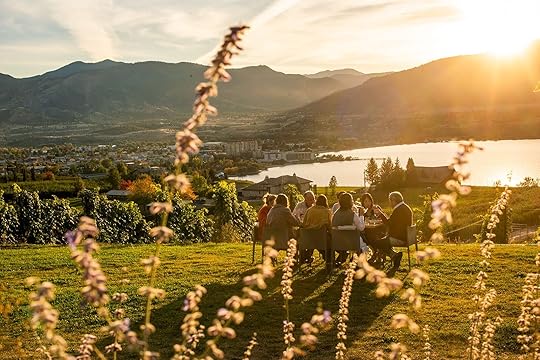
Poplar Grove Winery in Penticton. Photo: Destination British Columbia
With great wine comes excellent food at many wineries in Valleys & Vineyards. In Oliver, The Sonora Room at Burrowing Owl Estate Winery serves contemporary lunches and dinners in a window-lined space with expansive vineyard vistas. Manzil Restaurant at Kismet Estate Winery plates regional Indian cuisine, including a multi-course tasting menu that might take you from lentil fritters, tandoori shrimp, and butter chicken to chai-infused semolina cake.
Home Block Restaurant at CedarCreek Estate Winery is one of the top dining spots in the Kelowna area, emphasising regional ingredients in dishes like wild seabass with roasted fennel or char-grilled ribeye paired with wilted spinach and cauliflower purée. Another high-end Kelowna option, The Restaurant at Mission Hill delights with creative cuisine on a scenic outdoor terrace where it’s easy to appreciate your surroundings.
At Poplar Grove Winery in Penticton, the menu reflects a deep respect for local farmers and seasonal ingredients, curated to pair harmoniously with the winery’s acclaimed wines. Meals like these are a welcome reminder of how many wonderful experiences in Valleys & Vineyards stem directly from the land.
Before or after any meal, take to the water for the ultimate digestif: movement. The calm, clear lakes around the Okanagan are ideal for stand-up paddleboarding or canoeing. Just as every bite of food tells a story about the land, so does every paddle dip — one more gesture in sync with the easy, elemental pace that defines Valleys & Vineyards.
Learning about Indigenous cultures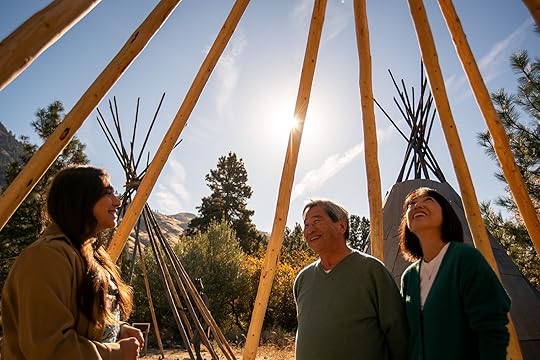
Nk’Mip Desert Cultural Centre in Osoyoos. Photo: Destination British Columbia
Indigenous Peoples in BC are the original stewards of the land. The Okanagan is situated on the land of the Syilx Peoples, whose deep-rooted care and respect for the land continue to shape the Okanagan in Valleys & Vineyards today. Gain insights into both the culture of the Okanagan People and desert ecology at Nk’mip Desert Cultural Centre, where walking trails wind through the desert hills. The Osoyoos Indian Band, which also operates nearby Nk’Mip Cellars, owns and operates the cultural centre.
The exhibits and worthwhile guided tours at the Indigenous owned-and-operated Sncewips Heritage Museum in West Kelowna trace the history and present-day culture and traditions of the Okanagan People. A short drive away, stop into the Indigenous-owned Kekuli Café for flavourful bowls and sandwiches — perhaps venison or smoked salmon served on bannock, a traditional bread in many Indigenous communities and served with every meal.
Exploring on two wheels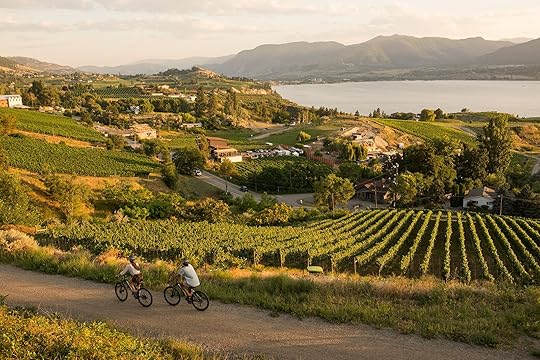
Biking the Kettle Valley Railway. Photo: Destination BC / Kari Medig
In the temperate autumn months, cycling is among the most pleasant ways to get around the Okanagan and Boundary Country. The region’s premier multi-use path is the Kettle Valley Rail (KVR) Trail, which follows a former rail line 305 miles from Midway to Hope. Continuing from the Columbia Western Rail Trail, which stretches through the Eastern part of Boundary Country, the KVR begins in Midway, where you can explore the area’s rail history before pedaling the gentle stretch to Greenwood, passing through quiet grasslands and riverside valleys and heritage towns.
One of the most dramatic sections is the Myra Canyon Trail outside Kelowna, where you can pedal across 18 wooden trestle bridges high above the canyon, taking your time to soak up every view. Get your wheels from Myra Canyon Bicycle Rental and Tours, located at the trail entrance.
Another section of the KVR takes you along the Naramata Bench and through Penticton, with vistas across the vineyards down to Okanagan Lake. Popular with walkers, runners, and cyclists, this route passes trailside craft beer-maker Abandoned Rail Brewing Co. and several of the Naramata Bench wineries.
North of Kelowna, the Okanagan Rail Trail runs beside the turquoise waters of Kalamalka Lake. Rent an e-bike from Pedego Electric Bikes Oyama at the lake’s southern end and pedal north toward Kal Beach. Here, you can pick up coffee, muffins, or a picnic lunch at the always-bustling Rail Trail Café & Market.
Enjoying time to unwind and nights to remember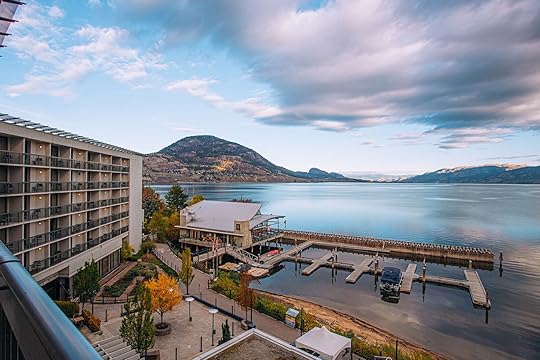
Penticton Lakeside Resort. Photo: Destination BC / @vancouverfoodie
Overlooking Okanagan Lake in Vernon, Sparkling Hill Resort & Spa is the largest luxury spa in British Columbia. Besides its seven steam rooms and saunas — plus a heated year-round infinity pool — KurSpa houses a Cryo Cold Chamber. You’ll spend up to three minutes in a room set to -110°C for an experience designed to energize your circulatory and nervous systems. At the opposite end of the valley, Solterra Desert Spa at Spirit Ridge in Osoyoos uses heat in treatments like the Desert Stone Massage, warming and relaxing your muscles after your adventures. All trips to Valleys & Vineyards inherently promote well-being, but at spas like these, wellness is made literal.
When it comes to choosing a place to lay your head, know that accommodations range from resort hotels to eclectic inns and winery guesthouses — all of which invite you to check in, slow down, and immerse yourself in natural rhythms. Independent guesthouses and B&Bs dot the valley, especially around Penticton, Naramata, and Kelowna. Campgrounds near Skaha Lake and Okanagan Lake provide scenic backdrops for outdoor lovers, while upscale options include Watermark Beach Resort on the shores of Osoyoos Lake, along with the aforementioned Spirit Ridge and Sparkling Hill Resort & Spa.
In Kelowna, Hotel Eldorado at Eldorado Resort blends classic elegance with modern convenience and proximity to urban wineries and dining. Just south, Summerland Waterfront Resort & Spa provides a restful base, and Penticton Lakeside Resort is a longtime favorite for those wanting to explore both the Naramata Bench and the vibrant arts and food scene in town.
Many wineries in Valleys & Vineyards also have accommodations that allow you to sleep among the vines, including the 10-room Guest House at Burrowing Owl Estate Winery and The Inn at Therapy Vineyards along the Naramata Bench. One unique lodging sits above the tasting room at Liquidity Wines in Okanagan Falls: The Loft at Liquidity is a contemporary two-bedroom apartment with a gourmet kitchen and views that extend across hills and vineyards. When you’re ready to continue your wine-tasting, all you have to do is wander downstairs.
In a province filled with dramatic landscapes, diverse culture, and a sensibility that comes from being so in tune with the landscape, Valleys & Vineyards still manages to stand out. This is nature and luxury in one — a place to reconnect with yourself, nature, and your friends and family. 
Finde Deinen Rhythmus in Nature’s Heartland, British Columbia
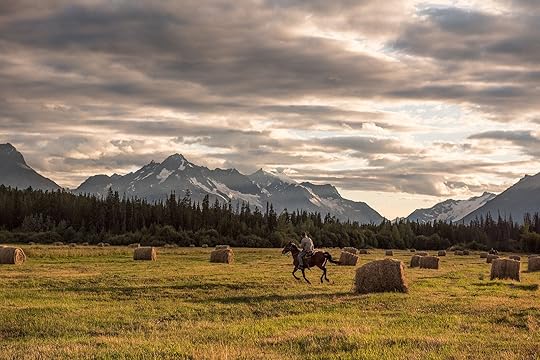
Aus der Vogelperspektive hoch über Nature’s Heartland in British Columbia, vielleicht während eines malerischen Rundflugs, genießt du ein atemberaubendes Panorama aus Bergketten und Regenwäldern, Lavaplateaus und Weideland, reißenden Flüssen und Gletscherseen. Durch all dies fließt der Fraser River, der längste Wasserweg in Central British Columbia, der in den Rockies entspringt und sich seinen etwa 1.368 Kilometer langen Weg bis zum Pazifik südlich von Vancouver bahnt. Entlang des Flusses sind Naturdenkmäler wie der Fraser Canyon entstanden, eine der beeindruckendsten Schluchten Nordamerikas.
Was man allerdings aus solch einer Höhe nicht erkennt, ist die fesselnde Geschichte, die Seite an Seite mit diesen Landschaften steht. Indigene Menschen leben hier seit Jahrtausenden, und ihre Kulturen, Traditionen und ihr verantwortungsvoller Umgang mit der Natur prägen Nature’s Heartland heute noch. Stell dir vor, du sitzt am Lagerfeuer, lauschst den seit Generationen überlieferten Geschichten eines Stammesältesten, umgeben von genau den Landschaften, in denen diese Geschichten angesiedelt sind.
Die Region trägt viele Geschichten in sich, von den tief verwurzelten kulturellen und spirituellen Verbindungen der indigenen Bevölkerung bis hin zum Pelzhandel und Goldrausch, die das Land und seine Bewohner verändert haben. Heute spiegeln sich sowohl indigene als auch Traditionen der Siedler in lokalen Zusammenkünften und Veranstaltungen wider. Rodeo ist nach wie vor ein reger Bestandteil des Gemeinschaftslebens hier.
Neben eher besinnlichen Erlebnissen wie dem Besuch eines Goldrausch-Museums, dem Angeln auf Lachse oder dem Beobachten von Elchen, Adlern, Bären und Karibus in ihrem natürlichen Lebensraum, hat Nature’s Heartland auch für abenteuerlustige Reisende einiges zu bieten. Zu den Highlights für Adrenalinfans zählen Wandertouren durchs unberührte Hinterland, ein Rundflug über den Tweedsmuir Provincial Park mit seinen farbenprächtigen Vulkanlandschaften und atemberaubenden Wasserfällen, Kanutouren auf den endlosen, miteinander verbundenen Seen und Flüssen des Bowron Lake Canoe Circuitoder rasante Abfahrten auf den steilen Mountainbike-Trails rund um den Fox Mountain.
Ob du nun Ruhe oder Abenteuer findest, Nature’s Heartland wird dich noch lange nach deiner Rückkehr begleiten.
Unterwegs dort, wo Natur und Geschichte verschmelzen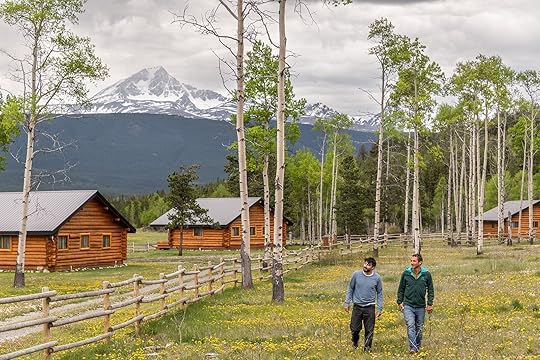
Nemaiah Valley Lodge. Foto: Destination BC / Kari Medig
Eine der besten Möglichkeiten, einen Eindruck von Nature’s Heartland zu bekommen, ist von der Stadt Hope aus dem Highway zu folgen, der in den Fraser Canyon führt. Hier umrahmen steile Felswände einen Fluss, der seit Jahrtausenden Menschen trägt und Geschichten mit sich führt. Halte an der Alexandra Bridge, um über die historische Brücke zu spazieren, hoch über dem Wasser zu stehen und dir die unzähligen Reisenden vorzustellen, die bereits hier entlang gekommen sind.
Ein Stück weiter kündigt das Donnern von Hell’s Gate den dramatischsten Engpass des Fraser an, an dem jedes Jahr Millionen von Lachse gegen die Strömung kämpfen. Eine Fahrt mit der Luftseilbahn eröffnet eine spektakuläre Vogelperspektive, bevor es wieder zurück auf die Straße geht. Zwischen Hope und Hell’s Gate finden sich kleine Gemeinden mit großen Geschichten, wie beispielsweise Yale, einst eine boomende Goldgräberstadt und heute Heimat historischer Gebäude und lokaler Museen. Wenn es die Zeit erlaubt, verbringe eine Nacht am Fluss in einem Tipi oder Kuppelzelt und nimm wahr, wie die Geräuschkulisse des Fraser Canyon aus rauschendem Wasser und Wind die Stille erfüllt.
Wenn Du Lytton erreichst – wo trockene, mit Beifuß bewachsene Hänge in weitläufige Flussschluchten übergehen, die von schroffen Bergen umrahmt sind – hast Du eine Route zurückgelegt, auf der jede Kurve eine weitere Facette des Naturschauspiels und der Menschheitsgeschichte offenbart, die British Columbia prägen. Weiter nördlich geht es nach Lillooet, wo ein Besuch der historischen Hat Creek Ranch lohnt, die heute von der St’uxwtews Pesuten Heritage Society in Zusammenarbeit mit der Bonaparte First Nation betrieben wird. Hier werden die Geschichten und Traditionen der St’uxwtews Pesuten People gemeinsam mit der Siedlungs- und Goldrausch-Geschichte lebendig – durch Führungen mit kostümierten Darstellern, Schmiedevorführungen und Kutschfahrten.
Ein wichtiger Teil jedes Roadtrips in der Region ist das Kennenlernen der indigenen Kulturen. Besuche das Xatśūll Heritage Village, hoch über den steilen Ufern des Fraser River gelegen auf dem angestammten Gebiet der Xatśūll First Nation, dieTeil des Secwépemc (Shuswap) Volkes ist. An dieser Kulturstätte nahe Soda Creek kannst du traditionelle Grubenhäuser und Schwitzhütten erkunden, mehr über kulturelle Praktiken erfahren und einem Uferweg entlang des Fraser River folgen.
Alternativ lohnt sich ein Besuch bei der Nemiah Valley Lodge, ein Refugium tief im Hinterland der Chilcotin-Region, wo die Landschaft sich über kristallklare Seen, Blumenwiesen und offene Weiden erstreckt. Die Lodge wird von den Xeni Gwet’in geführt, und zu den angebotenen Aktivitäten zählen Angelausflüge, geführte Wanderungen sowie Erzählstunden der Tŝilhqot’in.
Wo das Ranchleben den Takt vorgibt
Reiten auf der Flying U Ranch. Foto: Destination BC / Kari Medig
Die Ranchtradition in British Columbia reicht bis in die 1860er-Jahre zurück, als Rinder nach Norden getrieben wurden, um die Bergarbeiter während des Goldrausches zu versorgen. In der Gegend zwischen Cariboo und Chilcotin – geprägt von Hochebenen, sanften Hügeln, dichten Wäldern und weiten Flusstälern – liegen einige der ältesten und geschichtsträchtigsten Ranches Kanadas. Dies sind Orte, an denen Pferde frei umherstreifen und das Leben sich nach den Jahreszeiten richtet: Frühling bedeutet Kalbzeit, Sommer das Einbringen des Heus, im Herbst stehen Viehtriebe an.
Genieße einen einmaligen Aufenthalt auf einer der Gäste-Ranches in Nature’s Heartland und nimm an den vielfältigen Aktivitäten teil. Auf der Echo Valley Ranch & Spa etwa beginnt der Tag mit Yoga bei Sonnenaufgang, gefolgt von einer geführten Wanderung oder einer E-Bike-Tour durch die Wälder. Gäste können zudem Überlebenstechniken wie Feuermachen oder das Bauen von Unterständen erlernen. Zwei Spas auf internationalem Niveau und gemeinschaftliche Farm-to-Table-Mahlzeiten hat die Ranch ebenfalls zu bieten.
Das Siwash Lake Wilderness Resort & Ranch ist ein Eco-Luxury-Hideaway auf Fünfsterne-Niveau. Als exklusiver Rückzugsort mit nur wenigen Gästen gleichzeitig verspricht es ein sehr persönliches Naturerlebnis, und so wird für die Teilnahme am erstklassigen Reitprogramm des Resorts für jeden Gast das passende Pferd ausgewählt. Die Ranch bietet über 100 Kilometer private Reitwege, Aktivitäten wie Fliegenfischen, Stand-up-Paddling, geführte Wanderungen und Radtouren. Übernachtet wird wahlweise in gemütlichen Lodge-Zimmern im Haupthaus oder stilvoll beim Glamping in luxuriösen Canvas-Zelten. Saisonale Bio-Gerichte und Spa-Behandlungen mit Zutaten aus der Wildnis verwöhnen Körper und Geist.
Ein historisches Erlebnis bietet die Flying U Ranch, Kanadas älteste Gäste-Ranch aus dem 19. Jahrhundert. Mehr als 100 Pferde und ein Wegenetz von rund 24.000 Hektar laden Gäste dazu ein, die Natur auf eigene Faust und im eigenen Tempo zu erkunden. Tagsüber sorgen abwechslungsreiche Aktivitäten wie Kanufahren, Bogenschießen, Lassowerfen und Angeln für Unterhaltung, während du abends Geschichten am Lagerfeuer, Live-Musik, Square Dance und herzhafte Hausmannskost genießen kannst.
Hoch hinaus über Wasserfälle, Gletscher und farbenprächtige Gipfel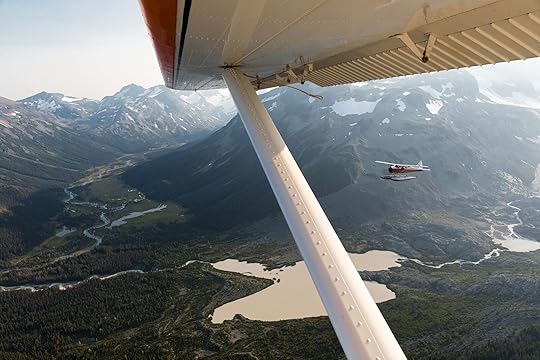
Rundflug im Tweedsmuir Provincial Park. Foto: Destination BC / Taylor Burk
Der Tweedsmuir Provincial Park gehört zu den malerischsten und ökologisch vielfältigsten Wildnisgebieten von British Columbia. Fast 10.000 Quadratkilometer groß und Teil des traditionellen Territoriums der Nuxalk und Ulkatcho First Nations, umfasst er raue Küstenberge, Gletscherseen, Bergwiesen, Basaltplateaus und dichten Regenwald.
Einen Teil seiner Faszination verdankt der Park seiner Abgeschiedenheit. Ein Großteil davon ist über Straßen nicht erreichbar, was ihn zu einem idealen Rückzugsort für diejenigen macht, die wahre Einsamkeit und Abenteuer in der Wildnis suchen. Besonders eindrucksvoll lässt er sich bei einem Flug im Wasserflugzeug erleben – das sind meistens De Havilland Beavers oder Cessnas, die vom Nimpo Lake aus starten. Bei diesen Touren hat man atemberaubende Aussichten auf Naturdenkmale wie die türkisen Gebirgsseen der Turner Lake Chain, die Hunlen Falls, einer von Kanadas höchsten Wasserfällen, die majestätischen Monarch-Eisfelder, die wie ein gefrorenes Meer wirken, und die surrealen Rainbow Mountains, ein uraltes Vulkanmassiv in Rot-, Gelb- und Goldtönen.
Die Flüge können auch Ausgangspunkt für mehrtägige Abenteuer sein: Die Piloten setzen Gäste in abgelegenen Regionen zum Kanufahren, Wandern oder Angeln ab und sammeln sie Tage später wieder ein. Ein Eintauchen in die Wildnis im wahrsten Sinne, Seite an Seite mit Bären, Elchen, Bergziegen, Wölfen und Karibus.
In Nature’s Heartland führen Straßen, Flüsse und Wege immer wieder zu neuen, unerwarteten Entdeckungen. Vom mächtigen, gewundenen Fraser River bis zu den sanften Hügeln des Chilcotin und darüber hinaus: Dieser Teil von BC zeichnet sich nicht nur durch seine Schönheit aus, sondern auch durch die Geschichten, die ihn bis heute prägen. Wer in Nature’s Heartland Zeit verbringt, nimmt eigene Geschichten mit nach Hause – Erinnerungen, die bleiben. 
The Great Wilderness: Find Endless Adventure in Northern British Columbia
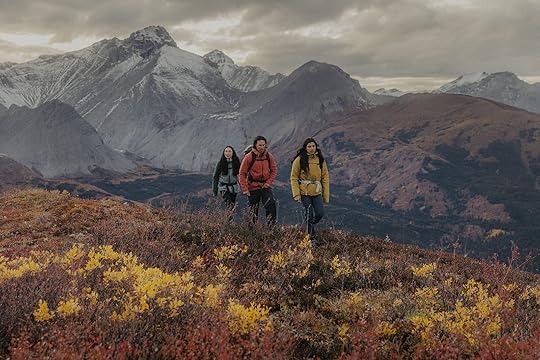
Imagine Yosemite’s peaks and the Pacific Northwest’s misty forests spread across an area larger than California. The air is crisp, carrying the scent of pine and freshness from glacial melt, and the landscape stretches beyond the horizon. This is The Great Wilderness, a region of British Columbia where wildlife roams, Indigenous Peoples have stewarded the land for millennia, and there’s a lifetime’s worth of nature to explore.
For outdoor-loving Californians, The Great Wilderness is a dream trip that can easily be made a reality. Getting off-grid here means experiencing the terrain at its most dramatic while being welcomed by the communities that call it home. It’s the perfect soulful hideout — and it’s all just a flight (or exciting road trip) away.
Setting out into the vastness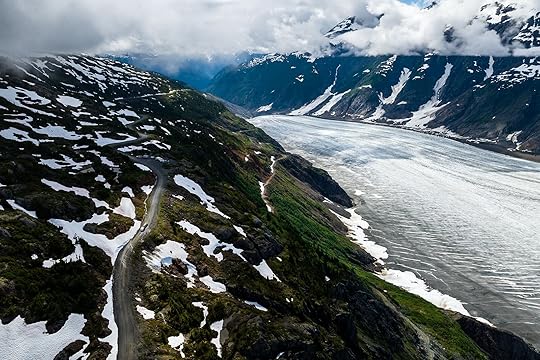
Salmon Glacier. Photo: Northern BC Tourism/Andrew Strain
In northern BC, The Great Wilderness is a patchwork of ancient and protected lands crowned by a sky so expansive it resets your sense of scale. Whether you’re summiting alpine peaks, swimming in turquoise lakes, or meandering through scenic forests, you can hike, drive, or ride on horseback for days on end without seeing another person. The silence here is deeper than solitude — it’s the breath of the land itself.
One memorable way to revel in the wilderness is to drive the Stewart-Cassiar Highway from Meziadin Junction to Stewart, a former gold rush town on the Alaska border. Bear Glacier and Salmon Glacier — which is road-accessible — are two of the big names on the route, but they’re in good company with around 20 glaciers in total.
You’ll see all kinds of untouched natural areas as you drive this stretch. Before you reach Meziadin Junction, set up camp in Meziadin Lake Provincial Park for a gateway to Bear Glacier and a waterside perch where you can fish for your food, just like the province’s grizzlies and black bears do when they scoop up salmon for lunch. Moments like these are a reminder of our place in nature and the meaningful ways we share The Great Wilderness with all of its creatures.
Experiencing incredible parks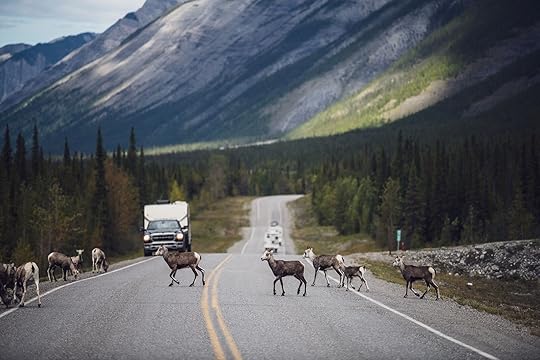
Stone’s Sheep crossing the Alaska Highway. Photo: Northern BC Tourism/Andrew Strain
The Great Wilderness isn’t just a destination. It’s a place with the power to transform. Every path followed, every lake paddled, and every quiet moment in the area’s spectacular parks yields more than just exploration — it sparks renewal.
Starting near the southern boundary of The Great Wilderness, Tumbler Ridge UNESCO Global Geopark offers a journey into the past, both geologically and historically. Home to a prehistoric reef that’s been transformed into rock formations over time, the site gives a rare glimpse into ancient marine environments and creatures — oh, and it also features 97-million-year-old dinosaur tracks. Hike the Shipyard-Titanic Trail to experience a series of gravity-defying rock towers, including the Titanic formation that resembles the iconic sinking ship, and be sure to have your camera ready.
From Dawson Creek, about 1.5 hours north of Tumbler Ridge, the striking Alaska Highway will lead you toward the Yukon border. This leg of the journey is where some of the region’s provincial parks start to shine, namely Charlie Lake and Pink Mountain, where you can fish, canoe, hike forested trails, and become part of nature’s rhythm.
At the Muskwa-Kechika Management Area, wildlife like black bears, bison, moose, caribou, wolves, mountain goats, and wolverines coexist. To see more animals in their natural habitat — not to mention boating and a long list of other activities centered around its eponymous jade-green lake — continue on to Muncho Lake Provincial Park. As you do so, prepare for more awe-inspiring sights, such as Liard River Hot Springs (one of the largest in Canada), hidden amid boreal spruce forest as you near the Yukon border.
Blending wilderness and humanity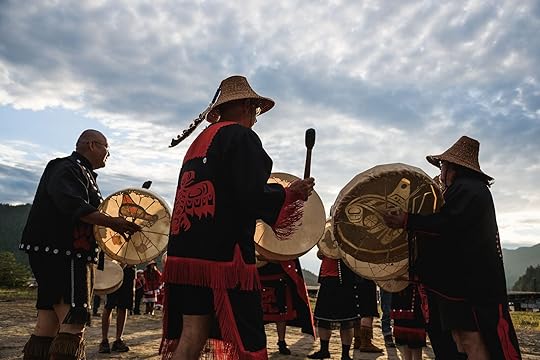
The Gitmaxmak’ay Nisga’a Dancers and the Wii Gisigwilgwelk Dancers in Port Edward. Photo: Destination BC/Dave Silver
By this point, The Great Wilderness has already lived up to its name, but there’s plenty more to experience. Northern BC Route 16 runs east to west through the entire region and connects the Canadian Rockies and the Pacific Ocean. When you hit the Great Bear Rainforest, you’ll find the world’s largest coastal temperate rainforest and the home of the Kermode (or spirit) bear, a black bear that actually exhibits white fur due to a recessive gene. As with many of the wonders you’ll come across as you venture into The Great Wilderness, the spirit bear is revered by First Nations in the area as a symbol of the deep connection between human and nature.
To get in touch with that connection, tackle one of the multi-day trails in Mount Robson Provincial Park (the Berg Lake Trail is one of the most spectacular in all of Canada). Elsewhere, pay your respects at Nisg̱a’a Memorial Lava Bed Park, whose otherworldly formations were created by a series of eruptions from Mount Tseax around 250 years ago. For the Nisg̱a’a Nation, this land is more than a testament to nature’s power — it’s a sacred memorial preserving the memory of the villages and lives lost to the natural disaster, a place where stories of resilience and remembrance endure. At the Nisg̱a’a Museum, you can hire an Indigenous guide to explore and explain the terrain.
It’s the presence of Indigenous communities in The Great Wilderness — the Tlingit, Gitxsan, Nisg̱a’a, Wet’suwet’en, Tahltan, Lheidli T’enneh, and Carrier Sekani, to name a few — that lends the region such significance. To set foot on this land is to step into living history, where geography backdrops time-honored stewardship and deep spiritual and cultural ties. Within these territories, you’ll also find abundant wildlife, from bears, wolves, moose, elk, and deer to eagles and the occasional lynx and cougar. To understand the tenet of coexistence that defines The Great Wilderness, visit the village of Witset on the banks of the Bulkley River to see members of the Wet’suwet’en Nation demonstrating traditional salmon-fishing techniques.
Taking advantage of the seasons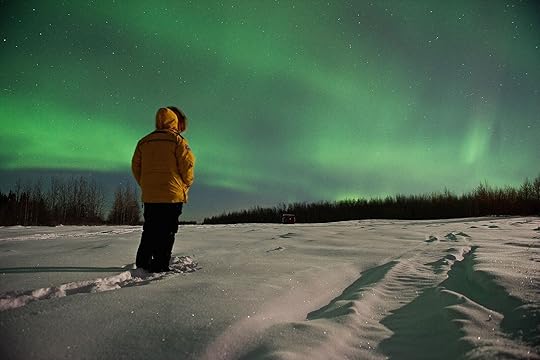
Northern lights neat Fort Nelson. Photo: Northern BC Tourism/Chris Gale
The Great Wilderness is great year-round, but if you visit in winter, you’ll get to experience an extra degree of quietude and magical snow coverage. You’ll also greatly increase your chances of seeing the northern lights. The Alaska Highway — notably the sections around Dawson Creek, Fort Nelson, and Muncho Lake — has the requisite wide-open landscapes, minimal light pollution, and stunning backdrops to reveal nature’s greatest light show.
Much as the aurora borealis transforms the already breathtaking BC sky into something unforgettable, The Great Wilderness invites transformation — not just in the way you travel but in the way you see the world. Perspective awaits in its vastness, clarity awaits in its silence, humanity awaits in its communities, and the thrill of adventure awaits in its beauty. Put simply, The Great Wilderness is a “once-in-a-lifetime” trip that’s so accessible to Californians that you can take it repeatedly — learning more about the area, and yourself, every time. 
Travel by Land, Sea, or Sky, and Let The Infinite Coast in British Columbia Inspire Your Adventure

Just outside of Vancouver in British Columbia, ocean, rainforest, and mountains blend into The Infinite Coast, an area best explored slowly and intentionally. Summer means long days spent sailing with sunlight lasting late into the evening. Autumn yields world-class wildlife-viewing, whether you’re on the lookout for whales or bears. Winter spells magically moody landscapes and coastal storm-watching that will guarantee you never look at the sky the same way again.
Stretching from the Salish Sea in the south to the lush, rain-fed inlets of the Great Bear Rainforest to the north, the British Columbia coast is an area that demands total attention, with some areas only accessible by boat, floatplane, or on foot. It’s a place where geography shapes both ecology and culture, where you can stand under the canopy of old-growth rainforests, be awed by some of the most powerful creatures in North America, and follow where water and land converge while traveling along the Inside Passage. The rewards are remote wilderness, wildlife, and Indigenous experiences unique not just in BC but in North America.
Most trips to The Infinite Coast start in Victoria. From there, you can travel by ferry through island-dotted passageways to waterfront communities on Vancouver Island or connect to the Sunshine Coast via a combination of ferry routes and scenic drives. Travelling on the water immediately makes trips here slower and more deliberate, allowing you to watch, listen, and pay attention to the rhythms of the natural world.
Escape to where the forest meets the sea…
View of Sechelt Inlet from West Coast Wilderness Lodge in Egmont. Photo: Destination Canada
Despite being on the mainland, you can’t drive directly to the aptly named Sunshine Coast in BC. Instead, plan to board the first of the ferries you’ll take on this journey, arrange a private boat, or opt for a seaplane. Its isolation gives the area an island-like feel and helps to preserve its tranquil atmosphere.
Once you arrive, the Sunshine Coast feels worlds away from city life. The laid-back pace, cedar forests, and oceanfront communities like Gibsons and Sechelt blend art, nature, and wilderness. Orcas and seals are common sights in Sechelt, and attractions like the shíshálh Nation’s tems swiya Museum and the Tsain-Ko Native Gifts & Art shop pay homage to the area’s deep Coast Salish Indigenous roots.
…and follow quiet inlets to solitude.
Kayaking on Desolation Sound. Photo: Destination BC / Andrew Strain
To reach the northern Sunshine Coast, take a scenic ferry ride to Powell River, a gateway to some of the most unforgettable adventures in the region. Just beyond lies Lund, a quiet harbour town with a bakery, tour operator, and place to stay: The Lund Resort at Klah ah men. This also puts you close to one end of the roughly 112-mile Sunshine Coast Trail, which stretches through remote forests and alpine ridges from Sarah Point on Desolation Sound all the way to Saltery Bay and the Jervis Inlet. Many sections are accessible for pleasant day hikes, with coastal views and picnic-friendly rest stops for a gentle introduction to the terrain. If hiking’s not on your itinerary at all, you can still reach Desolation Sound from Lund by boat, water taxi, or kayak.
Desolation Sound may host the largest marine park in BC, but it’s an oasis of solitude. When you get there, spend days paddling between emerald bays, camping on rocky outcroppings, and falling asleep to the sounds of sea lions barking in the dusk. You’ll want to take your time, both to conserve energy and appreciate the surroundings — the fjords stretch inland for miles. On land, you might spot black bears navigating the gravel beaches. In the water, orcas reign supreme. Experienced paddlers can plan their own adventures, while guided trips are available out of places like Lund and Powell River.
For a truly elevated perspective, consider a flightseeing tour. Scenic flights over Desolation Sound and the neighbouring fjords yield bird’s-eye views of its sheltered coves and island-dotted waters — ideal for travellers seeking a refined way to connect with nature. In Campbell River, 49 North Helicopters runs both flightseeing and adventure tours that showcase the dramatic beauty of Desolation Sound from above.
Journey where trails, traditions, and tides converge.
Tofino, Vancouver Island. Photo: Destination Canada / Brian Caissie
Across the Strait of Georgia from the Sunshine Coast and Desolation Sound lies Vancouver Island, a destination that wows on arrival. Stop in Campbell River and set out in search of humpbacks, orcas, or grizzlies with Homalco Wildlife & Cultural Tours (offered seasonally from May to October) while learning about the deep connections that the Homalco First Nation have to this land and sea. After a day on the water, retreat to Naturally Pacific Resort, a luxurious coastal hideaway where modern suites, a full-service spa, and locally inspired cuisine at Carve Kitchen & Meatery ensure you end the day on a high note.
On the west coast of Vancouver Island lies Tofino, a world-renowned surf town where powerful waves meet vibrant arts and culture, and wildlife viewing opportunities abound. On the edge of town, the Tonquin Trail provides rainforest and coastal views and is a serene way to experience the natural beauty that defines the region. To meaningfully connect with the landscape through Indigenous knowledge, consider a culturally immersive tour with Ahous Adventures, owned and operated by the Ahousaht Nation.
Also in the area is Tla-o-qui-aht Tribal Park, an Indigenous-led conservation initiative. Encompassing four protected areas, the park includes tidal estuaries; wave-pounded beaches; wildlife-rich forests essential for migrating birds, wolves, and cougars; and ancient rainforests. Rooted in the Tla-o-qui-aht Nation’s principles of sustainability, these lands are a living expression of resistance, resurgence, and responsibility. Visitors can explore the park in respectful partnership with local guides and businesses who support the Nations Tribal Park Allies Program — enjoy river paddling adventures, cultural interpretation experiences, and a guided hike to a coastal First Nations Village.
Boutique hotels in town are the perfect place to experience the famous storm-watching during the late autumn and winter months. Properties such as the Wickaninnish Inn, Black Rock Oceanfront Resort, and Best Western Plus Tin Wis Resort allow you to take in the dramatic coastal weather from the comfort of your suite. In nearby Ucluelet, you’ll find a different testament to nature at Pluvio Restaurant, where artfully crafted tasting menus turn seasonal ingredients into a show that unfolds right on your plate.
Enter the realm of the Spirit Bear…
Spirit Bear on Great Bear Rainforest. Photo: Destination BC / Yuri Choufour
Travelling north, set your sights on the expansive, lush, and otherworldly Great Bear Rainforest. Getting there is half the experience — think floatplanes and remote drives through moss-draped forests — but the towering old-growth forests, salmon-fed ecosystems, and elusive white-furred Spirit Bear that await are well worth the journey.
The Spirit Bear is a subspecies of the American black bear, about 10 to 20 percent of which are born with a recessive trait that gives them cream-coloured fur in this region of BC. Their home in the Great Bear Rainforest is Indigenous territory — a region stewarded by coastal First Nations, including the Gitga’at and Kitasoo Xai’xais, who hold deep cultural and spiritual connections to the land and its wildlife. Salmon, in particular, are the lifeblood of this area, nourishing not only the bears, wolves, and whales that call it home but also sustaining the ways of life, economies, and identities of those who’ve lived here for generations.
Spirit Bear Lodge not only offers access to this wonderfully remote region but also immersion into a broader network of Indigenous-guided experiences that honour the ecological and cultural significance of the rainforest. Exploring the area with a First Nations guide is a chance to learn the ancient knowledge of the land while keeping an eye out for the rare bears, seen as guardians of the forest and liaisons to the spirit world. Humpback whale, sea lion, and other wildlife sightings round out the experience in the Great Bear Rainforest, making each day on the water or trail a journey through one of the richest coastal ecosystems in the world.
…and go where grizzlies rule.
Grizzly watching in the Khutzeymateen Grizzly Bear Sanctuary. Photo: Destination BC / Andrew Strain
Your wildlife adventures continue as you head farther north to one of the most remote places in North America: the Khutzeymateen Inlet and Khutzeymateen Grizzly Bear Sanctuary, the sole designated grizzly preserve in Canada. It’s accessible primarily by water from Prince Rupert.
In the sanctuary, small boats allow for low-impact viewing of bears in their natural habitats — be prepared for hours spent floating in silence, eyes peeled for the gorgeous animals. Because this sanctuary is protected and remote, one of the best ways to visit is by booking a package that includes your transportation and guides.
No single itinerary can capture the inexhaustible list of wonders on The Infinite Coast. Follow scenic ferry routes up the coast, or book luxury travel and resort packages that include pre-planned paddling or grizzly-watching adventures. For visitors from the UK with time to truly explore British Columbia, The Infinite Coast delivers rich and diverse experiences. The reason to visit isn’t one activity or one attraction — it’s immersing yourself in the varied nature of the coast as a whole. 
Matador Network's Blog
- Matador Network's profile
- 6 followers



